Aeronautica Militare Italiana (AMI – Italian Air Force) has allocated – and continues to do so – considerable resources (in human, financial and material terms) in its Flying Schools to maintain its pilot training process at the “state of the art” in order to guarantee high training standards for both its own pilots and for those sent by Allies and partner nations. Among the Flight Schools involved, the 61° Stormo (61st Wing) made no exception.
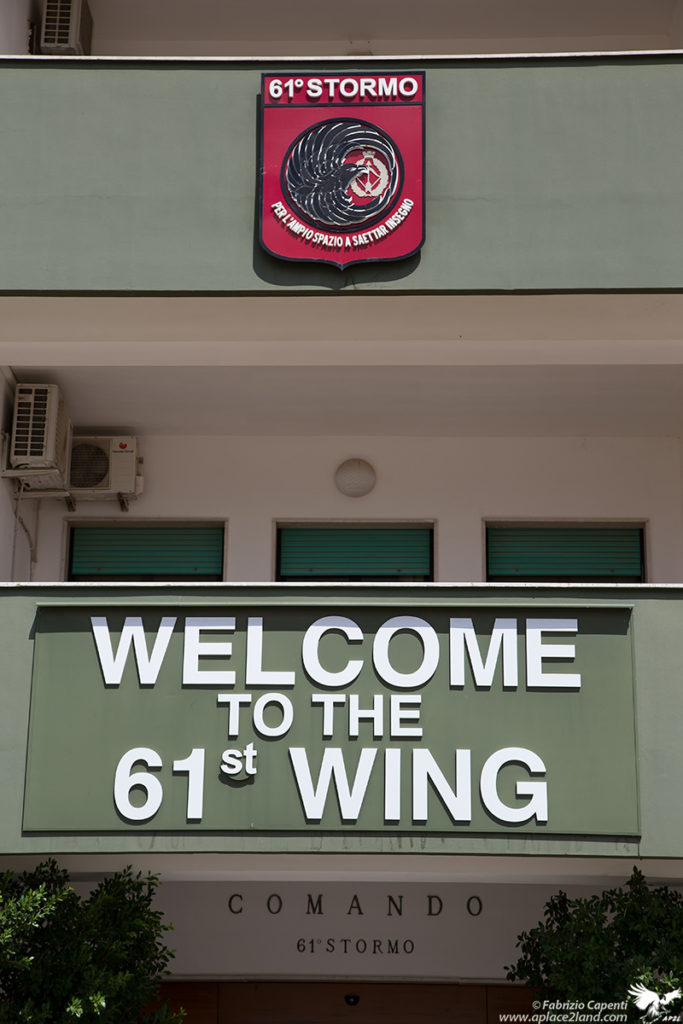
Building command of 61° Stormo
Introduction
Hierarchically dependent to the Comando Scuole AM/3a Regione Aerea (CSAM/3° RA – Command of the Schools of the ItAF/3rd Air Region), since its establishment in September 1946 as “Scuola di Volo delle Puglie”, the 61° Stormo is based at Lecce-Galatina air base, Puglia, in Southern Italy.
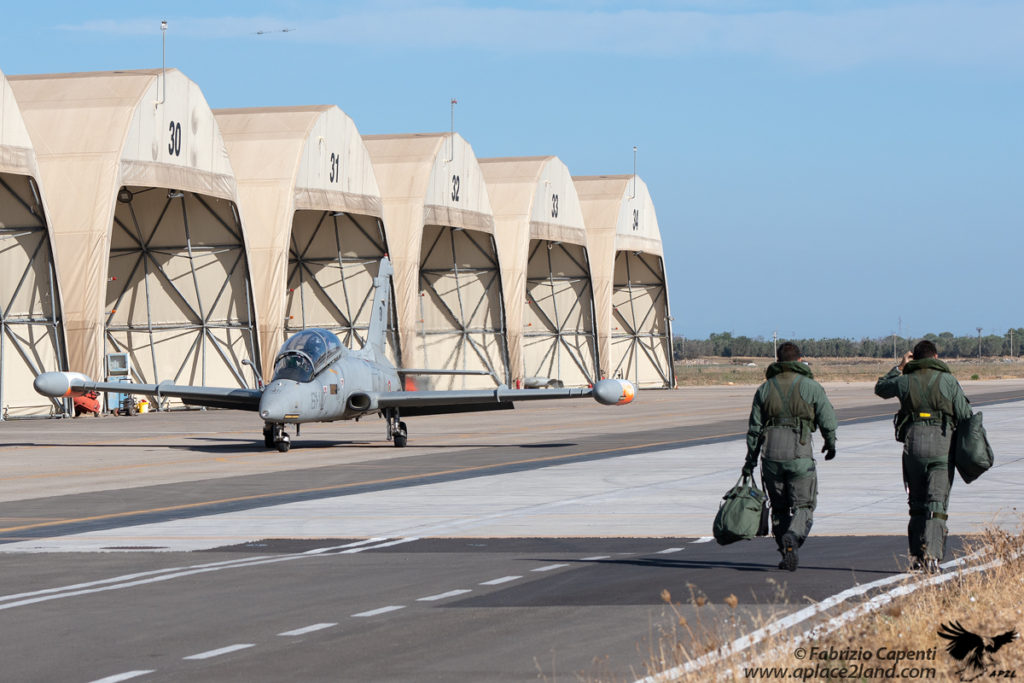
A normal scene during a day at 61° Stormo
Tasked for the fast jets training, the School gained a lot of interest from abroad, due the effectiveness of its modular syllabus. A fact confirmed by the growing number of foreign personnel hosted in Galatina thanks to international training agreements between AMI and other foreign air forces. The list include personnel from Argentina, Austria, France, Germany, Greece, Japan, Kuwait, the Netherlands, Poland, Qatar, Saudi Arabia, Singapore and USA which have flown in the past or are flying within 61° Stormo attending the flying courses or working as instructors.
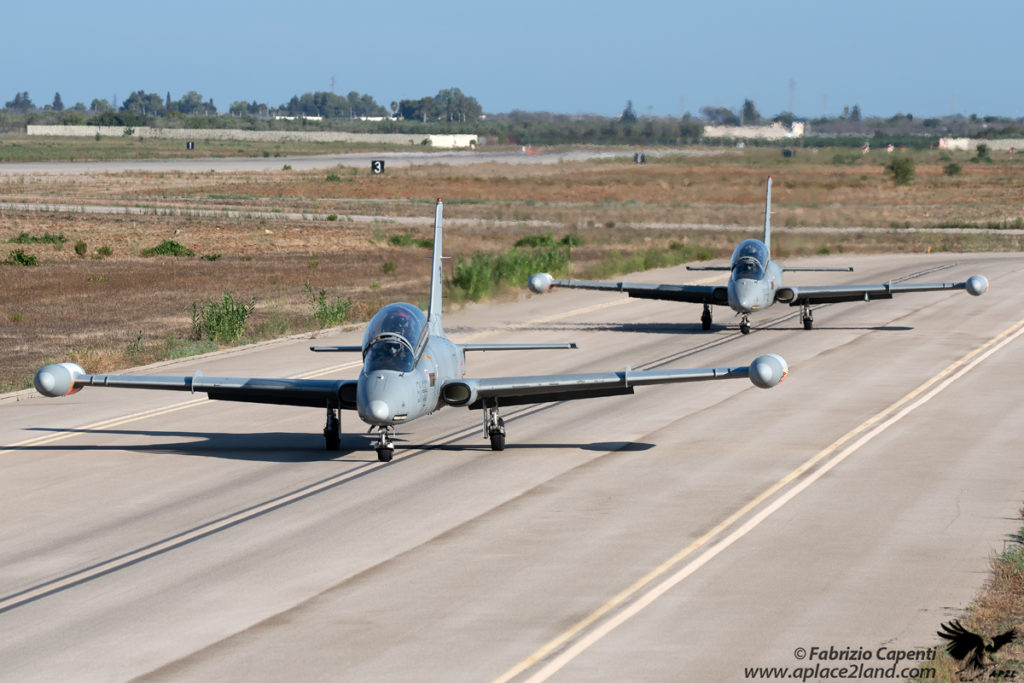
Mb-339A of 214° Gruppo Volo – 61° Stormo
Due to the high number of trainee pilots, the daily flight activity at Galatina is very intense, typically taking place in 3 or 4 waves for an average of 40/50 missions carried out every day by the three Gruppi Volo (flying squadrons) under the 61° Stormo’s command along with the IFTS.
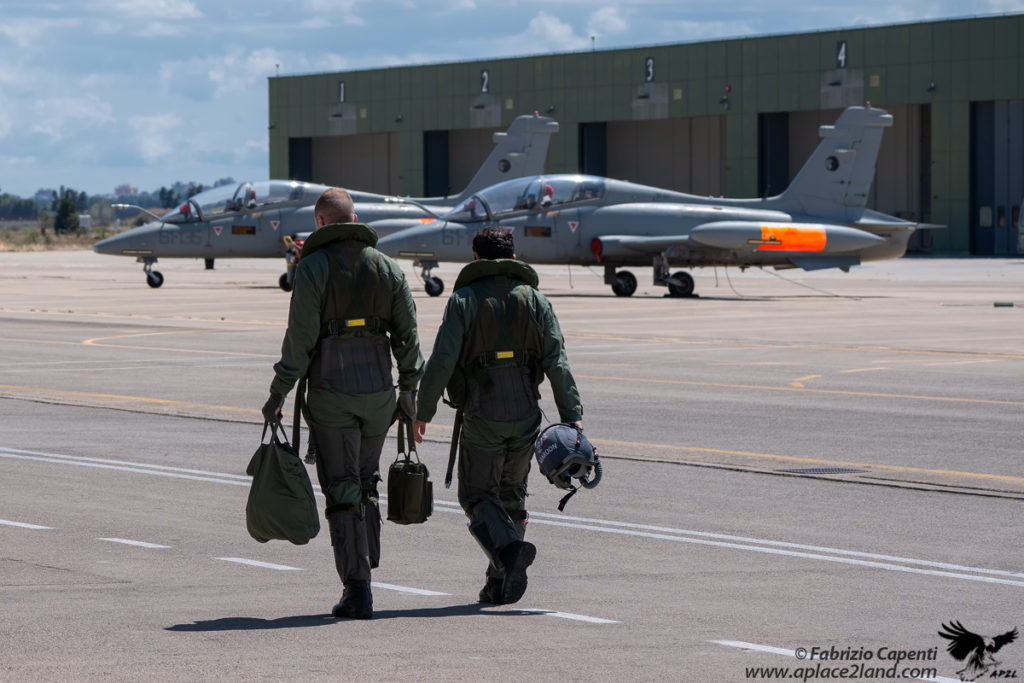
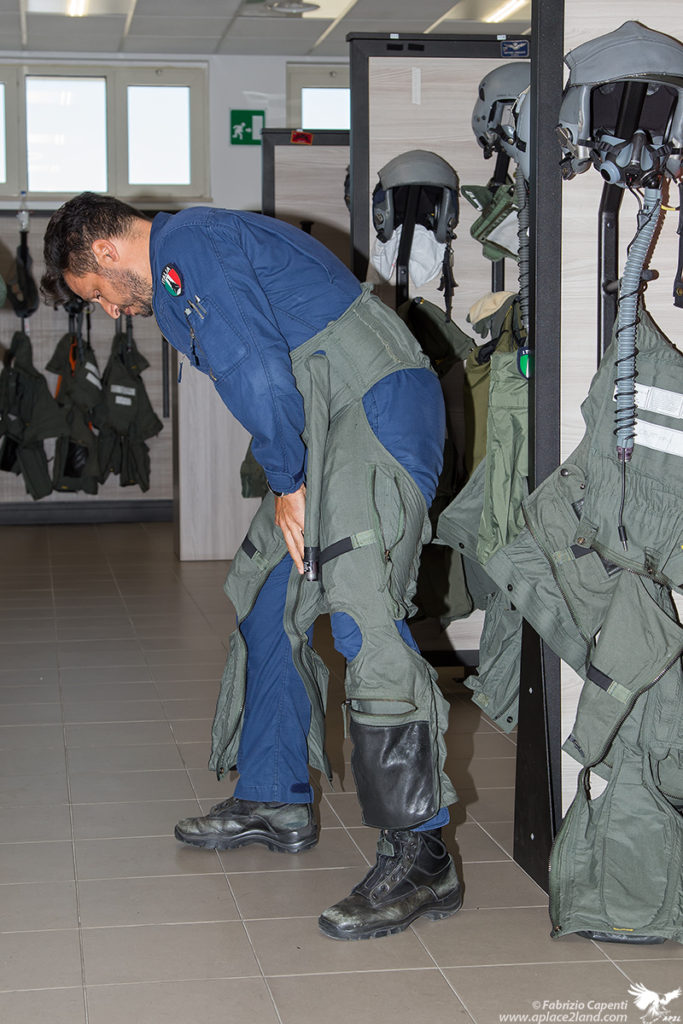
These are the 212° Gruppo, 213° Gruppo and 214° Gruppo, each one with a specific task within the fast jet training. Besides this, each one is also deputy to train its own instructor through a specific program called PIT (Pilot Instructor Training).
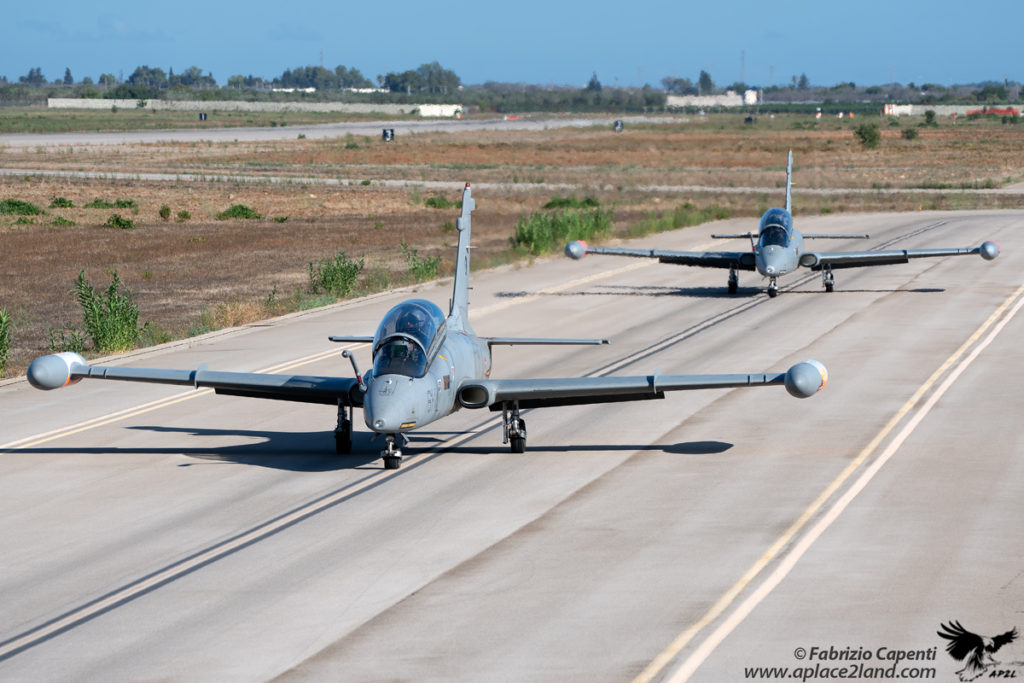
Mb-339CD 213° Gruppo Volo – 61° Stormo
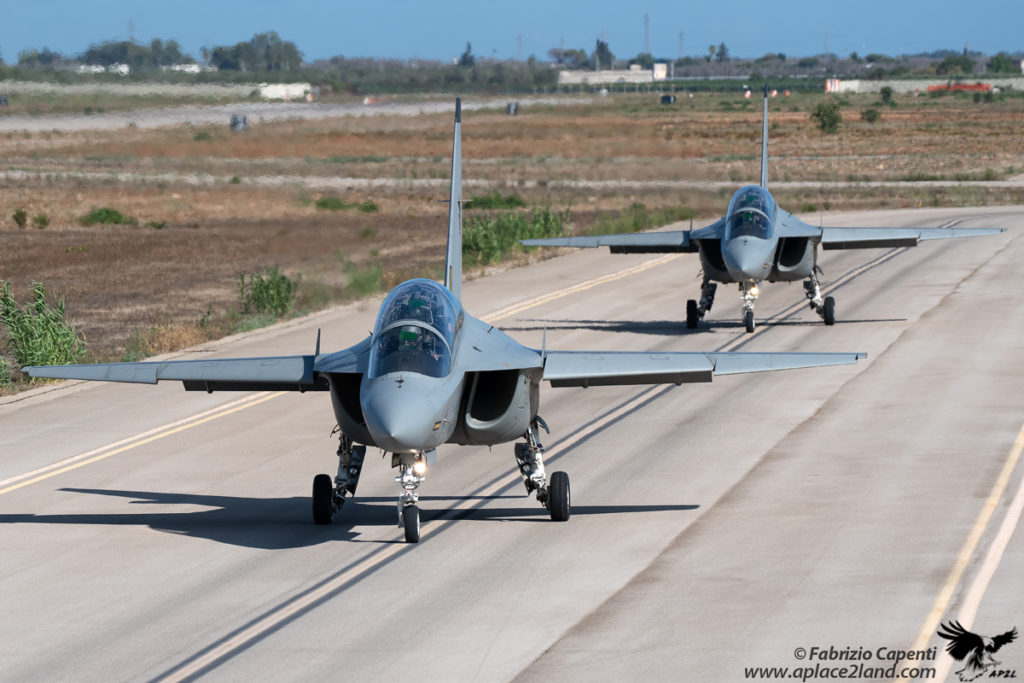
T-346A 212°Gruppo Volo – 61° Stormo
The maintenance of the huge number of airplanes based here is guarantee by 961°GEA (Gruppo Efficienza Aeromobili – Aircraft Maintenance Squadron).
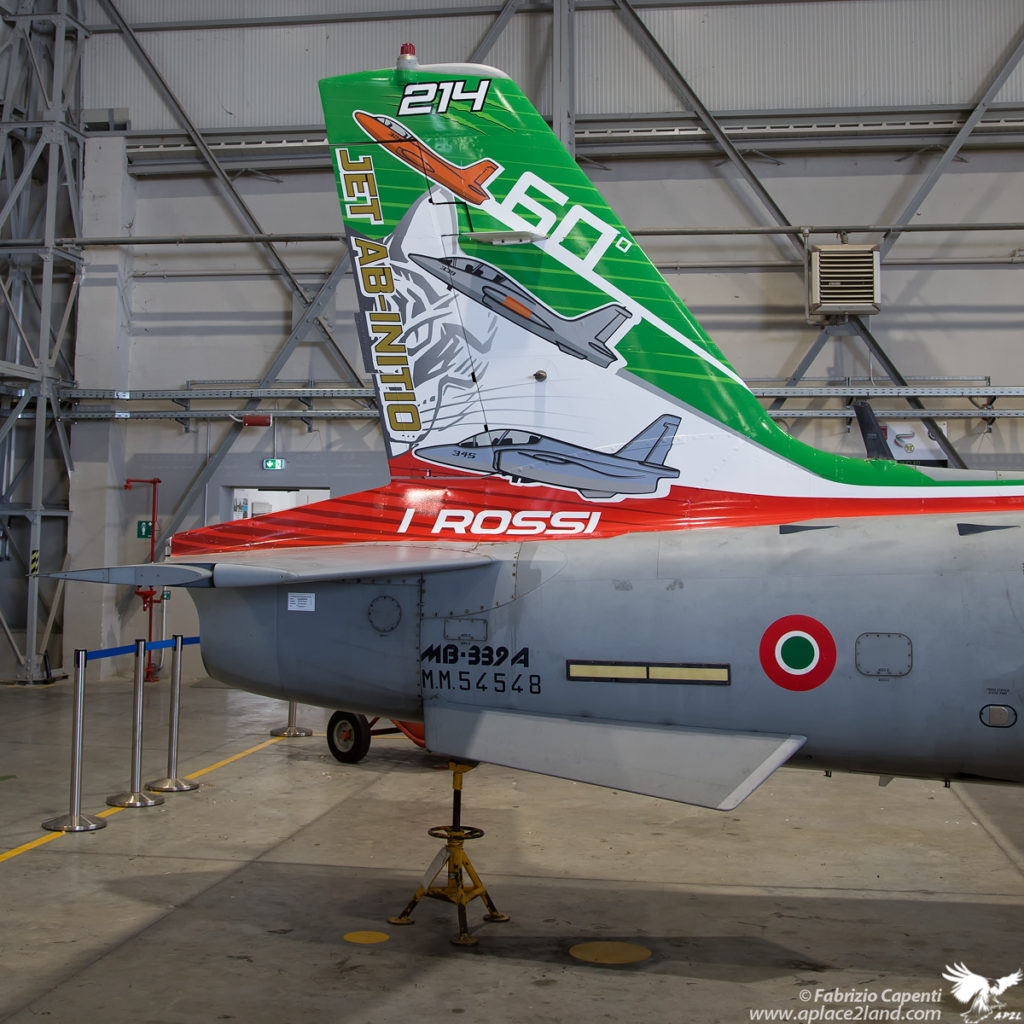
“Jet ab Initio” special tail of 214° Gruppo under maintenance at 961° GEA – 61° Stormo
The cadets selected to become pilots will go through the training process in the following phases:
- Phase 1 (Basic Pilot Training)
- Phase 2 (Primary Pilot Training)
- Phase 3 (Specialized Pilot Training)
- Phase 4 (Lead In to Fighter Training – LIFT)
214° Gruppo
Pilots beginning the so-called “jet ab initio” training, flying with the T-339A (military designation for MB-339A/MLU) the oldest version in service of the trainer, symbol and workhorse of the 61° Stormo since its introduction in 1982.
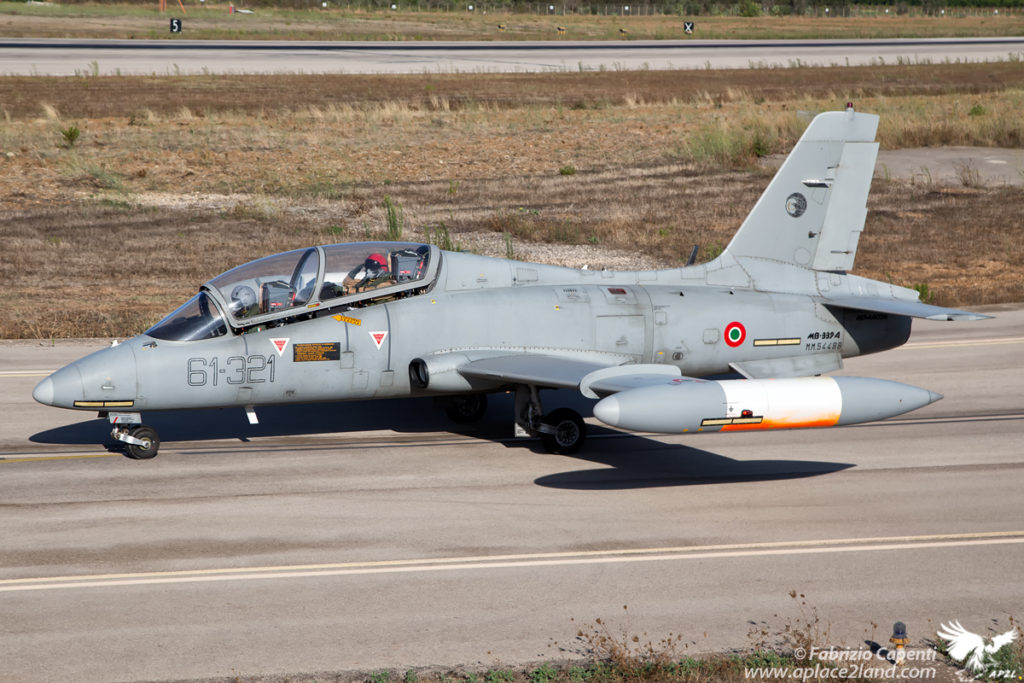
MB-339A 214°Gruppo – 61° Stormo on the way to the runway.
Its design was derived from the previous MB-326, sharing most of its airframe except for the forward fuselage, which was redesigned with a raised rear seat allowing better visibility for the instructor, and retaining the Rolls-Royce Viper turbojet engine, although in an improved version.
Over the years the MB.339A fleet received a Mid-Life Update (MLU) , mainly concerning radio and navigation equipment, including the GPS.
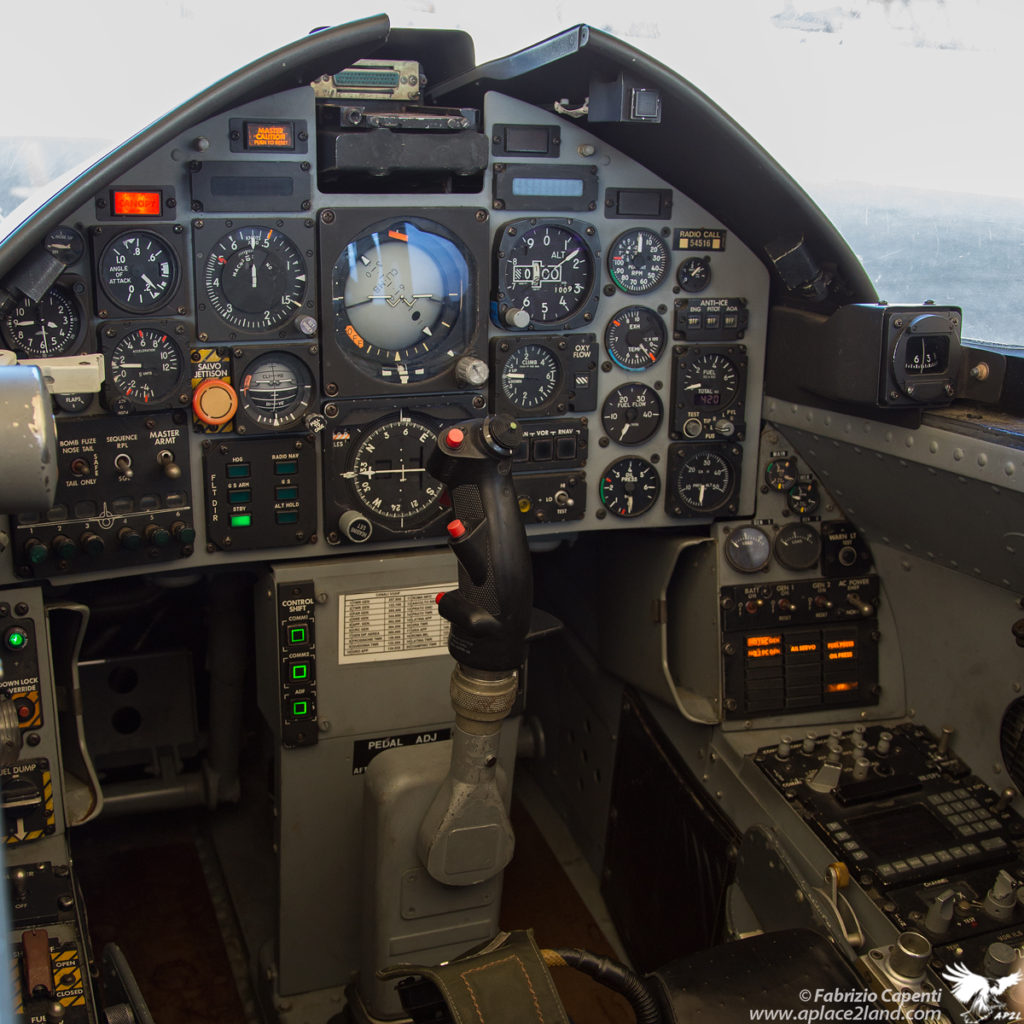
Mb-339A Front seater view
“Most student pilots are required to complete all courses and exams at the Air Force Academy, as well as a basic selection called Airplane Pilot License (“BPA – Brevetto Pilota d’Aeroplano” aka “Phase 1”) at the 70º Stormo in Latina – flying with the T-260B (designation for SIAI-Marchetti SF-260EA) piston engine trainer. They later on reach the 214° Gruppo in order to begin Phase 2. The only exceptions are those who are selected to fly Phase 2 in either Greece (Kalamata air base) or the USA (for example, in Sheppard AFB Texas, which hosts the ENJJPT – Euro-NATO Joint Jet Pilot Training program), both options equipped with the T-6 Texan II turboprop trainer. We also train foreign pilots who do not necessarily carry out Phase 1 in Italy, mainly depending on their Air Forces needs, therefore on the international agreements” explains Major O. A., instructor at the 214° Gruppo.
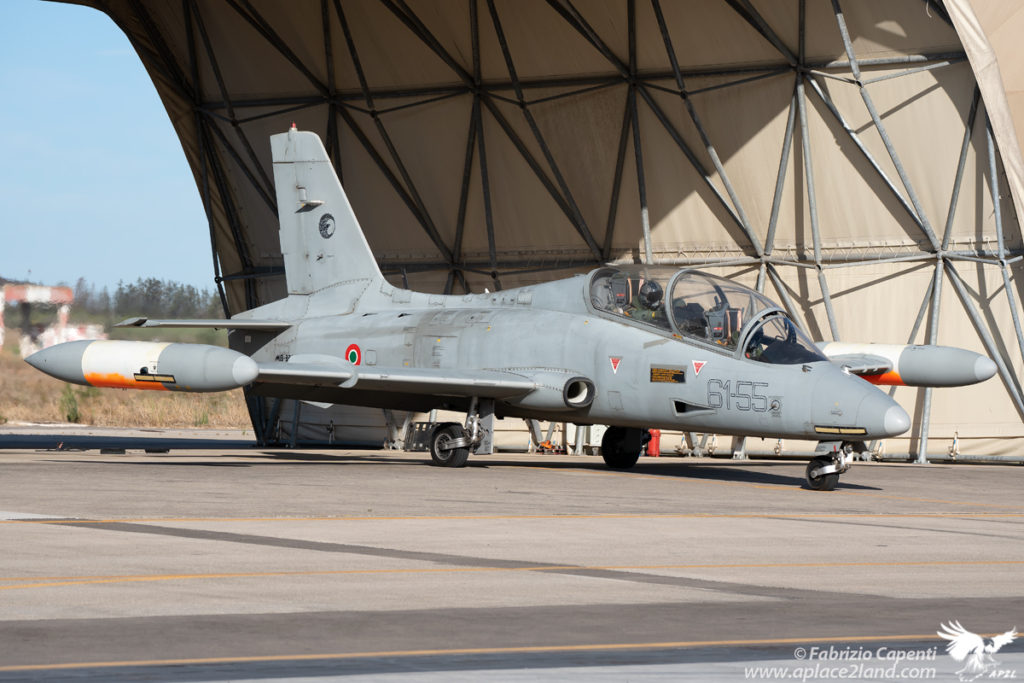
Mb-339A ready to taxi out.
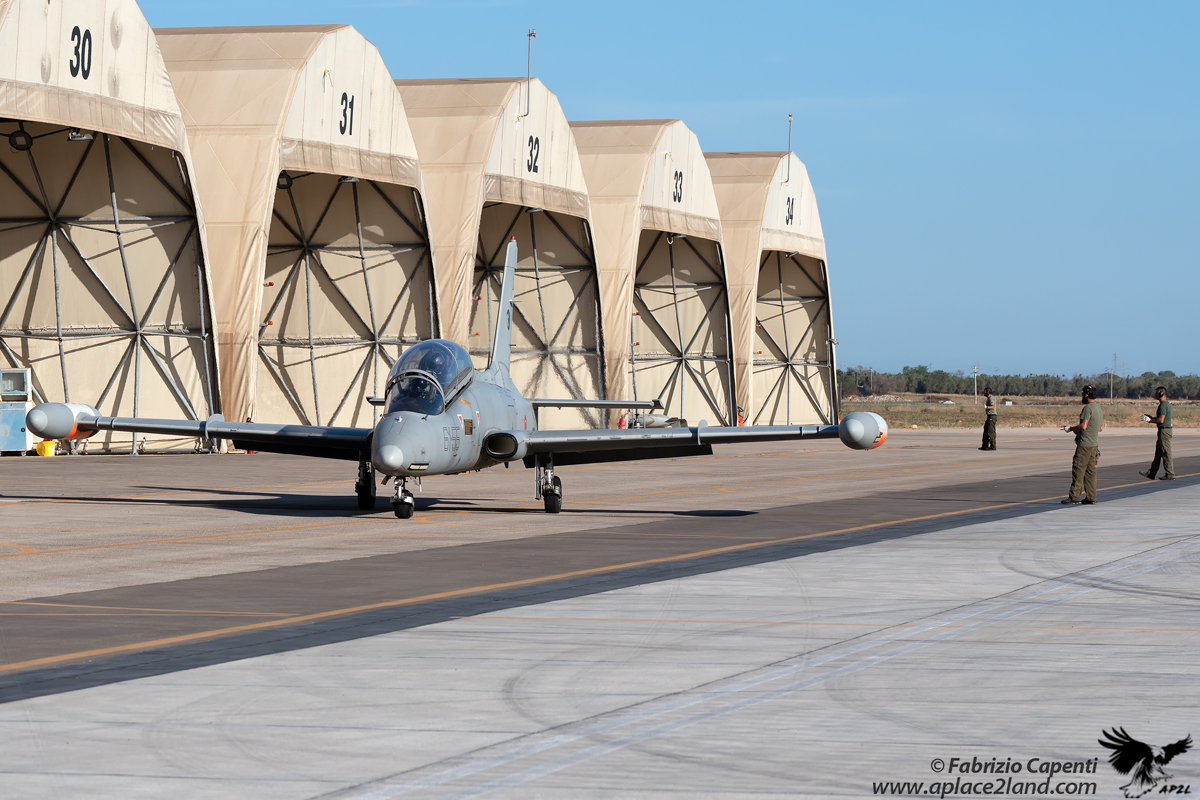
Mb-339A and its specialist
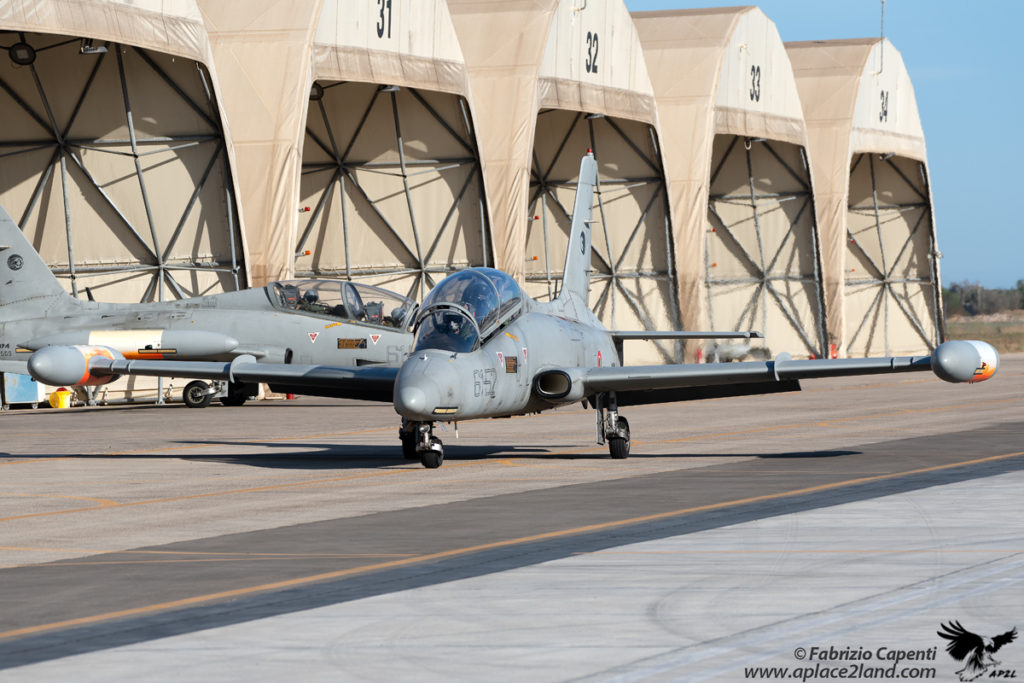
Mb-339A exits from hangar
Beside a ground school that lasts 25 days, the training syllabus consists of 37 sorties in 45 hours at the simulator and 75 flying sorties – including 6 solo flights – for a minimum of 88 hours. Consisting of 4 steps (“Contact”, “Instrument”, “Formation” and “Low Level”), this 6-month program allows students to become familiar with a wide range of aviation skills that will serve them well for the upcoming years: mission planning (weather, NOTAMS, route and fuel), aircraft handling (from basic take-off and landing to exploration of the flight envelope through aerobatics), radio communication procedures, emergency procedures management, instrument flights in adverse weather, mutual support in formation and the risks involved in low altitude and night flights.
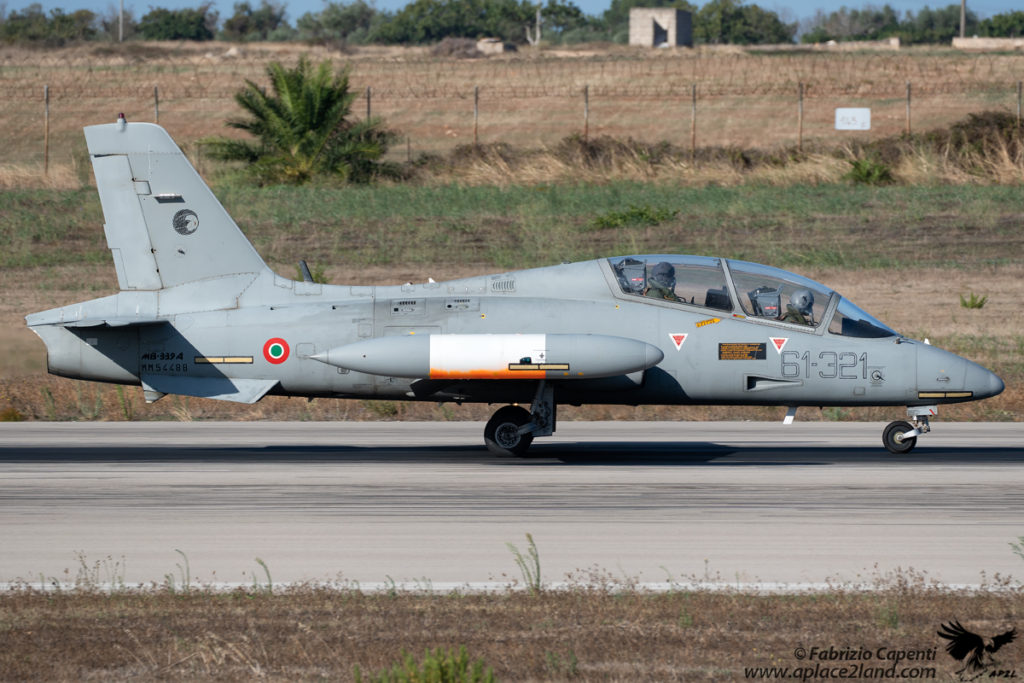
Take off run
“As instructors we come from different units: front-line, transport, helicopters. Such a different background allows us to better evaluate both the attitude and the trainees performances, in accordance with the task of the 214° Gruppo, i.e. “track selection”. The squadron determines the most appropriate role for each of student pilots. In fact, once successfully completed Phase 2, they are screened and selected to fly either fighters, UAVs, transport aircraft or helicopters”, Major O. A. concludes.
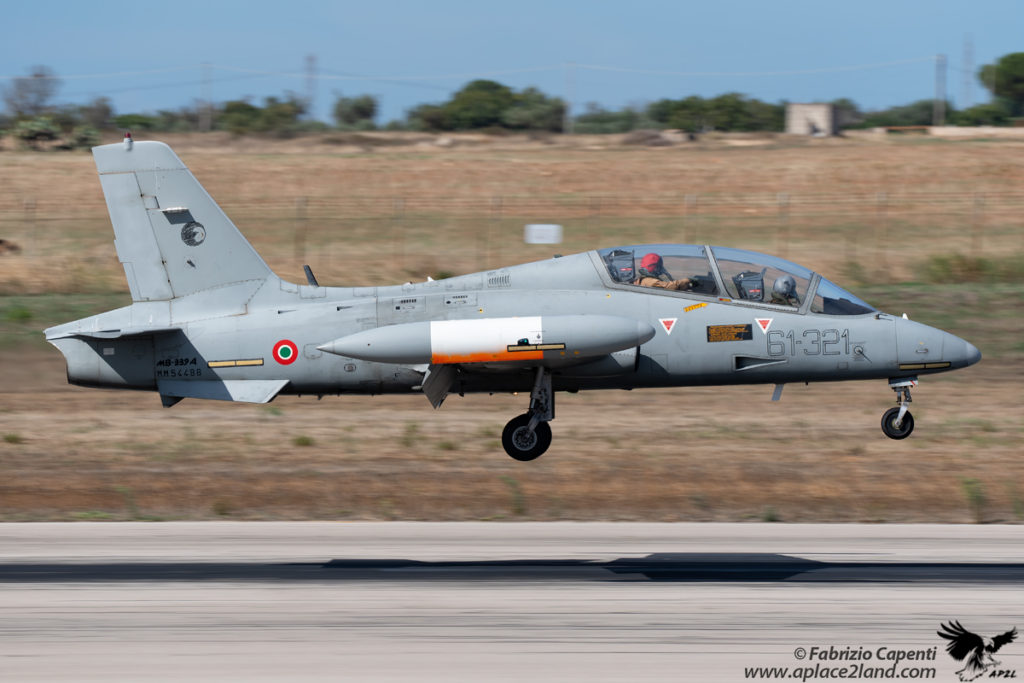
Back after an early morning training mission.
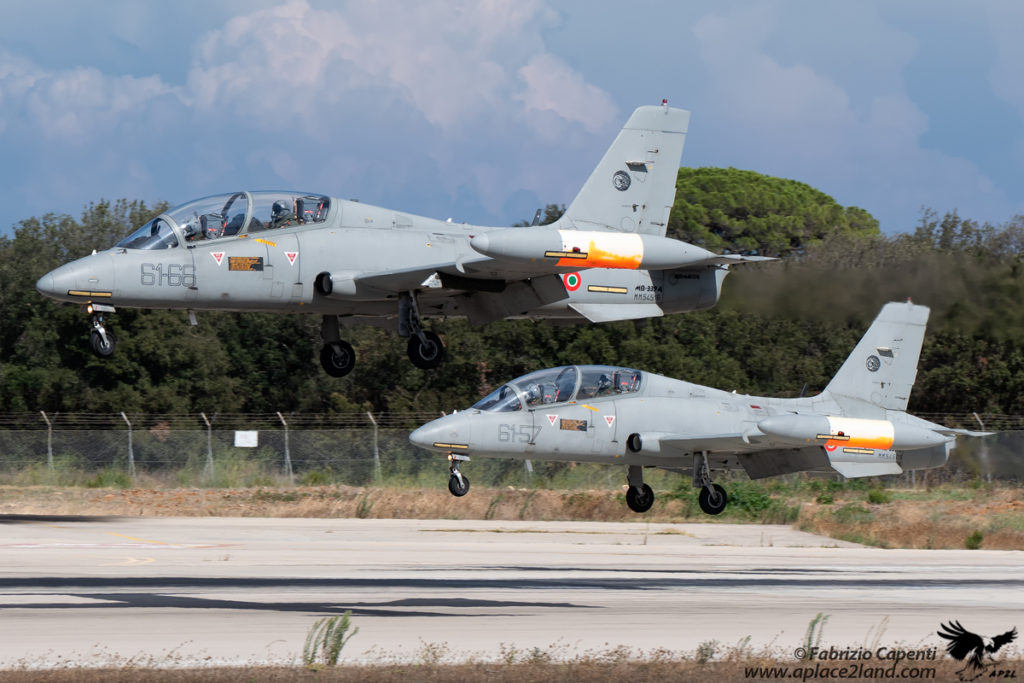
Pair landing
213° Gruppo
Those selected for fighter jet remain in Galatina, moving to 213° Gruppo Volo for Phase 3, flying the FT-339C (designation of MB-339CD).
“Charlie Delta” (stand for Completamente Digitale – Fully Digital) is the updated and improved version of the MB-339A. The main innovation consists in the glass-cockpit with three colors screens Multifunction Display that replaced the analogue one of the MB-339A and the Head Up Display for both pilots. Externally, the type features a new tail, a re-designed nose and the in-flight refueling probe.
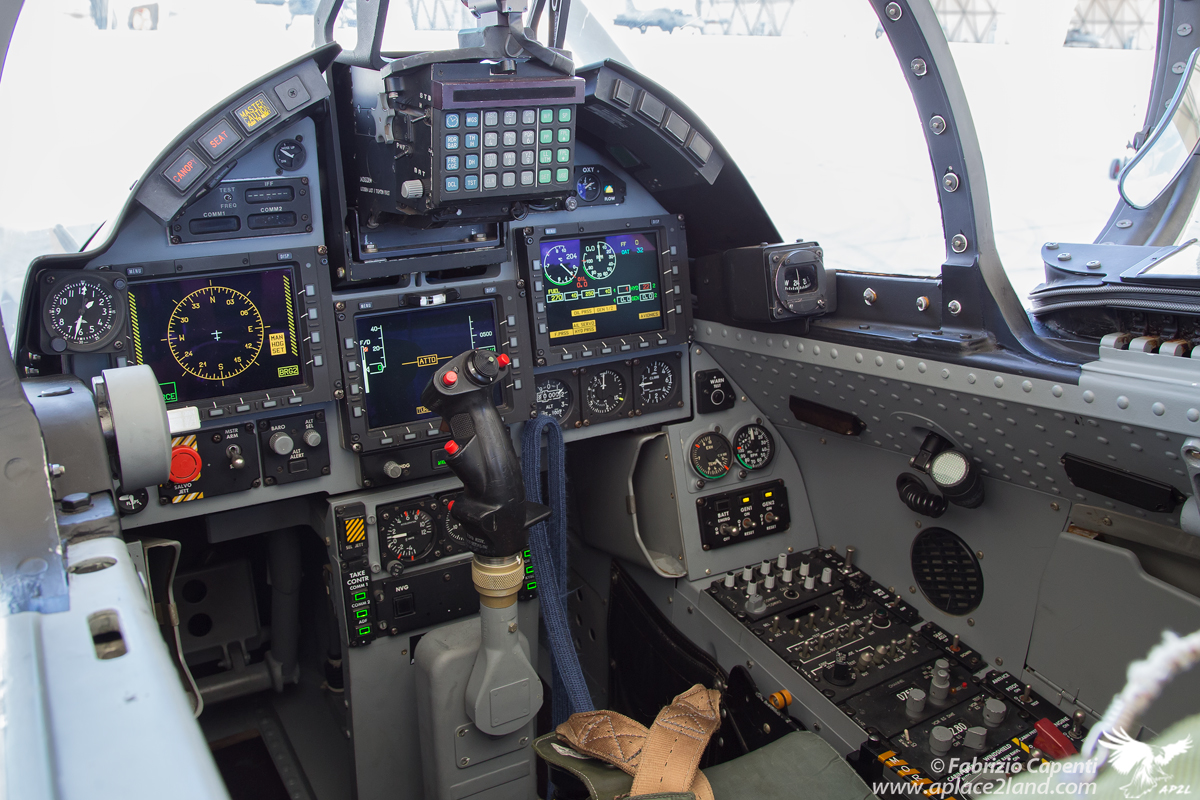
Mb-339CD Glass cockpit
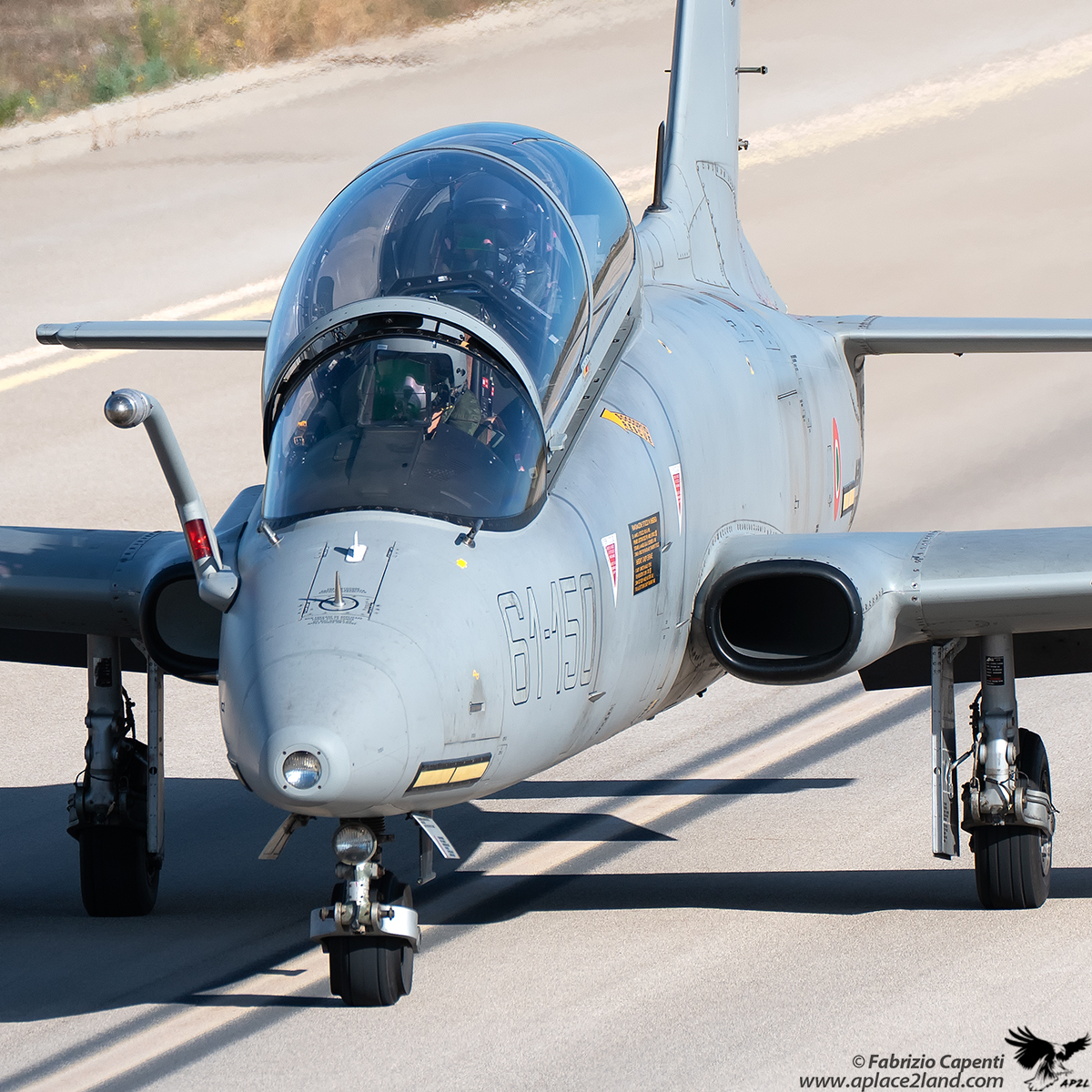
MB-339CD of 213°Gruppo Volo – 61° Stormo
As stated by Lt J. V. instructor pilot at the 213° Gruppo “The difference between “Alpha” version and “Charlie Delta” lies in the sensation of having heavier nose during landing due to the presence of refueling probe (also affect aerodynamic characteristics) and the weight of all the new avionics fitted in the nose. Systems and engine remain practically the same as the previous version, and also the flight performance are almost identical”.
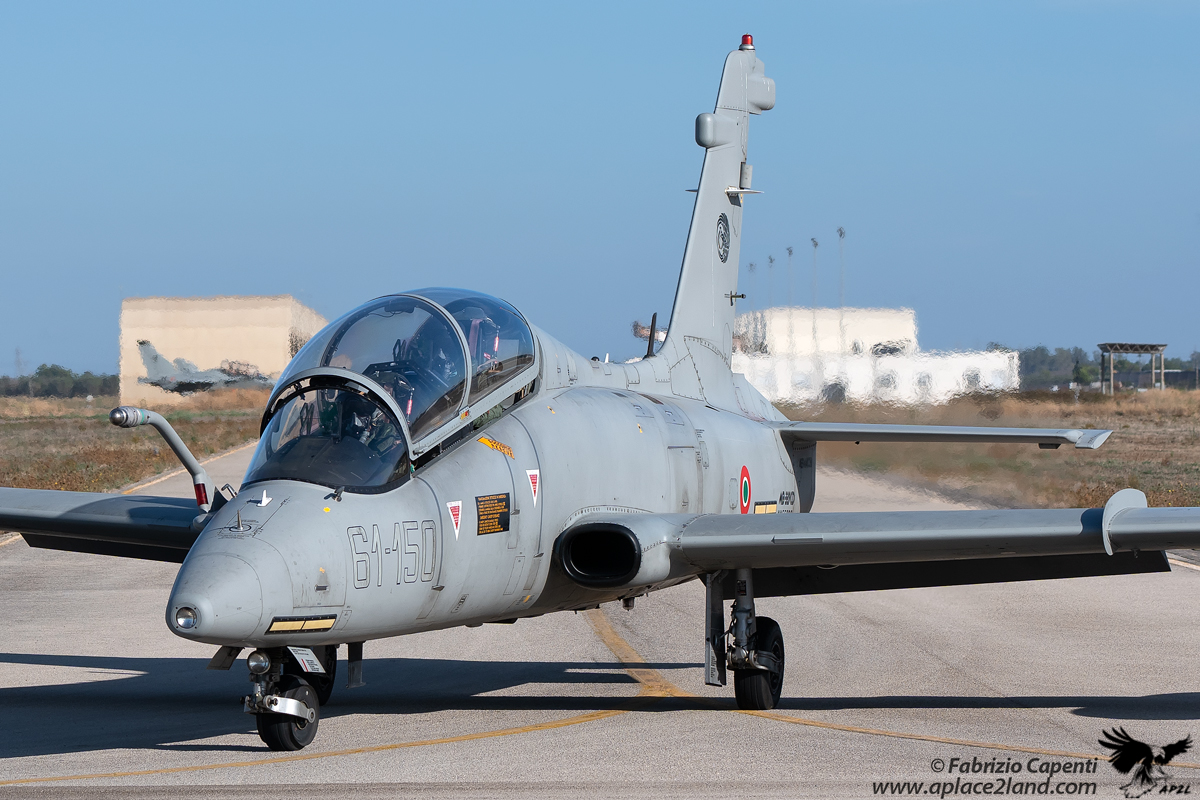
Mb-339CD refueling probe on the nose.
The aircraft handling is quite smoothly for those coming from 213° Gruppo (a minimum of 90,5 hours in 78 flying sorties plus 40 hours in 30 missions at simulator) while it takes a little longer for those who have attended Phase 2 abroad: “Having previously only flew the T-6 turboprop, they need to master a jet trainer first. In addition, they must familiarize themselves with the procedures and working areas around Galatina. In their case the ground school has a duration of 30 days instead of 15-20, followed by 118 hours in 92 flying sorties plus 48 hours in 38 missions at simulator.
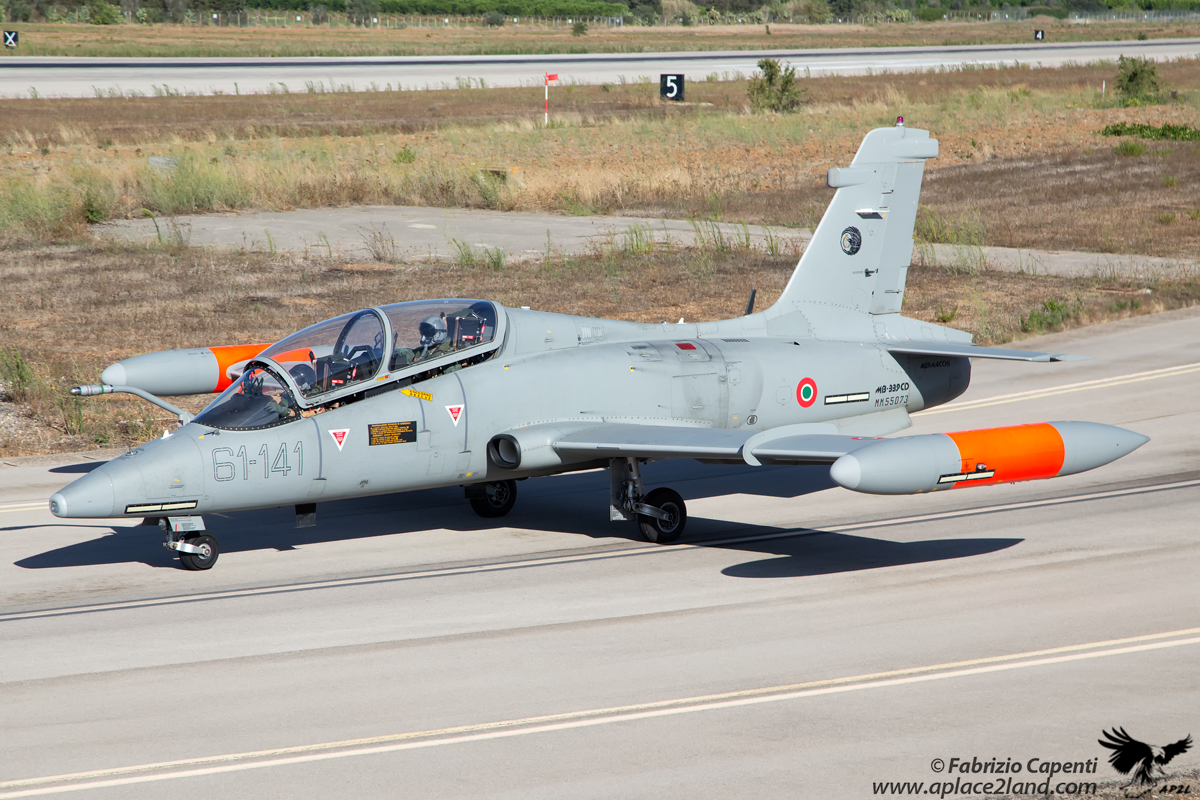
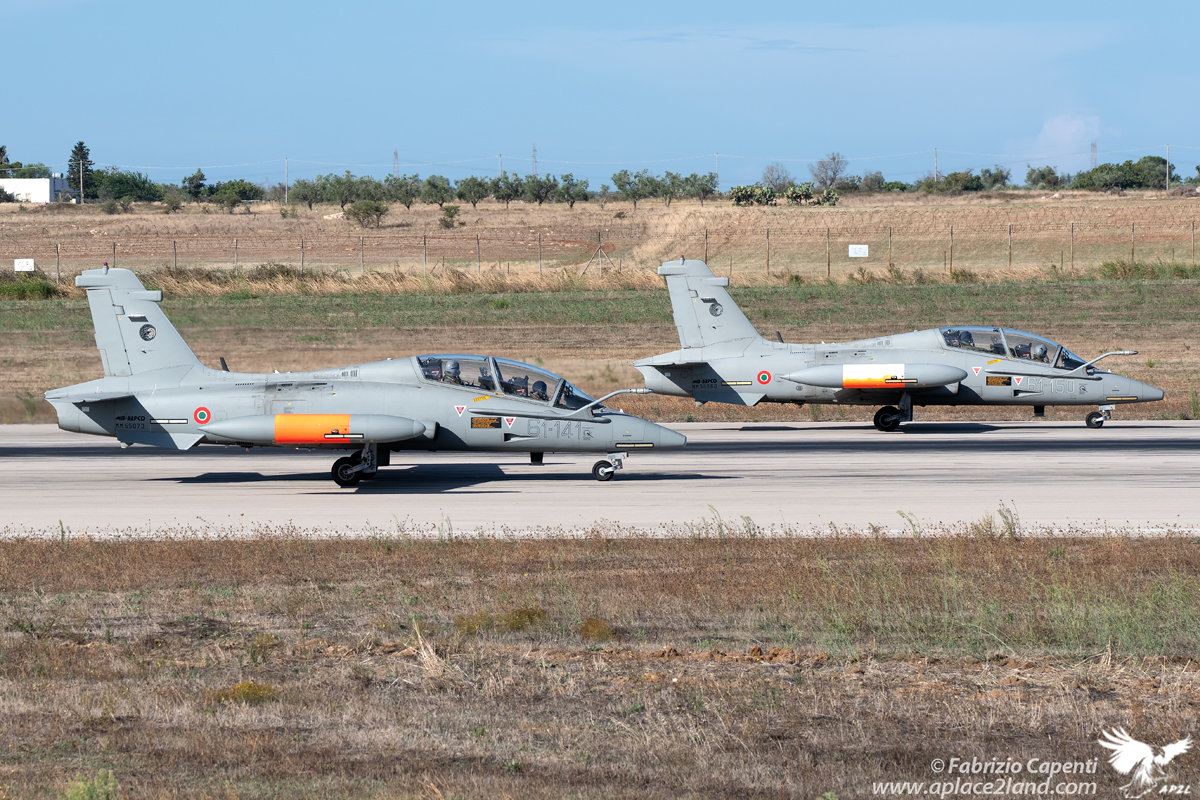
Two Mb339CD of 61° Stormo taking off together
Told about his experience as trainee pilot M.A. says: “You can see the different skills between those who do phase 2 with the turboprop and those who arrive from the jet. Going from being pulled by the propeller or pushed from behind with different engine response, with different times to climb and gain speed etc.. gives you a very different feeling! Moreover, coming from the T-339A it is thought to have similar airplanes, but actually switching from a fully analog to a digital cockpit with display and HUD is a big difference. All things already studied must be reviewed and deepened. The possibility of using the simulator is fundamental, because it allows you to repeat the procedure many times at “zero” cost”.
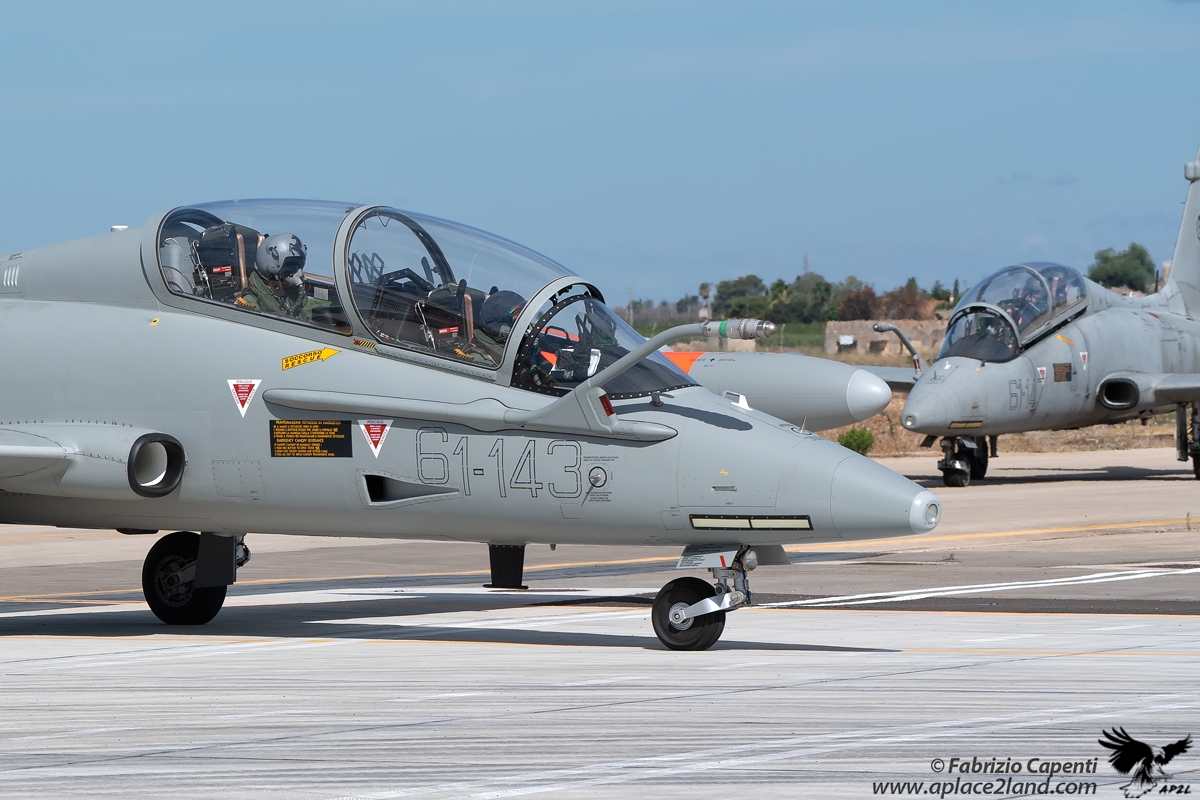
Having to prepare the trainees for the fighters, the instructors themselves – including the foreign ones – are former fighter pilot with “combat ready” status.
“They make us grow professionally by giving us more responsibility in flying. It is exciting to be in an international environment and with many foreign pilots. And then team up with the other trainee by studying and spending time together, sharing positive and negative experiences”.
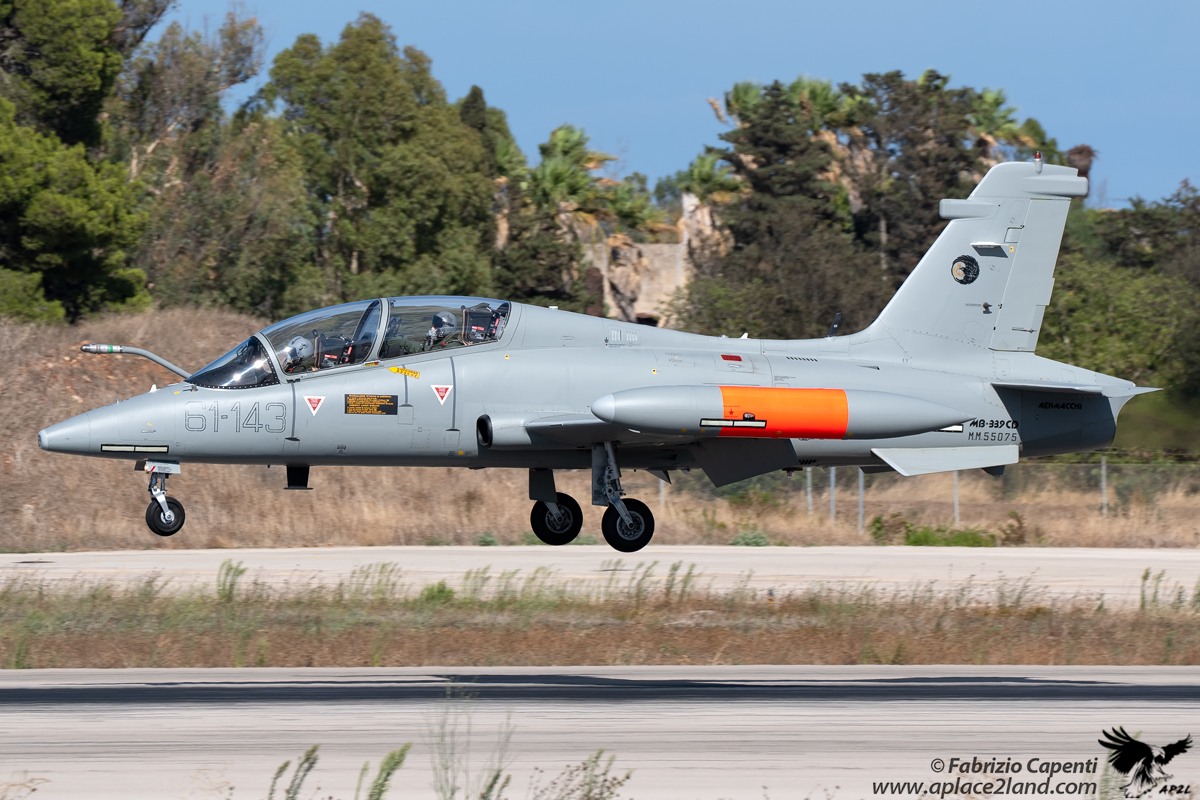
The syllabus goes on with the following steps called “Composite” (mixed flight VFR/IFR, aerobatic with G-force increase, high angles of attack), “Formation” (basic, advanced and tactical formation flight), “Low Level” and then proceeding with advanced handling, starting BFM (Basic Fighter Maneuvers), deployments at Decimomannu for air-to-ground activities at shooting range, in flight refueling and introduction to night flight (paying attention especially to visual illusions and spatial disorientation).
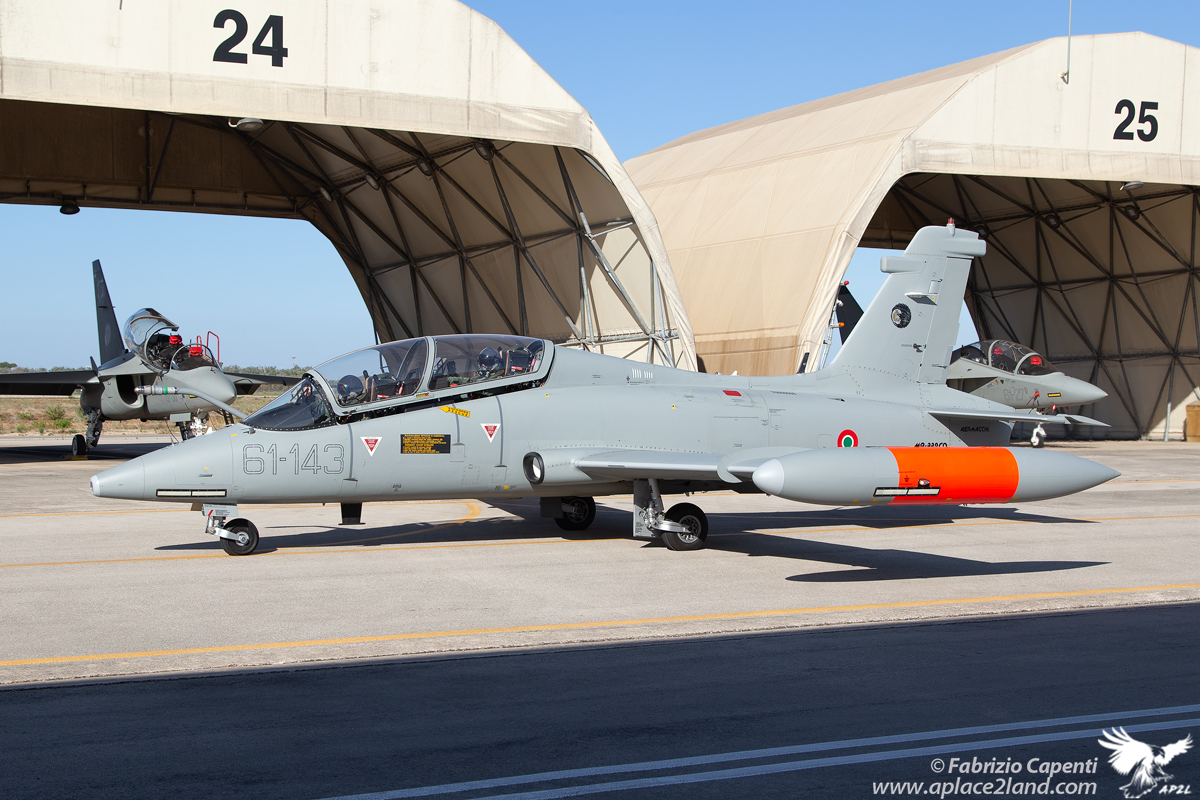
Upon the Phase 3 is completed obtaining the Brevetto Pilota Militare (BPM Military Pilot’s License) the pilots has the last step before their assignment to the 4th and 5th generation fighter at front-line unit.
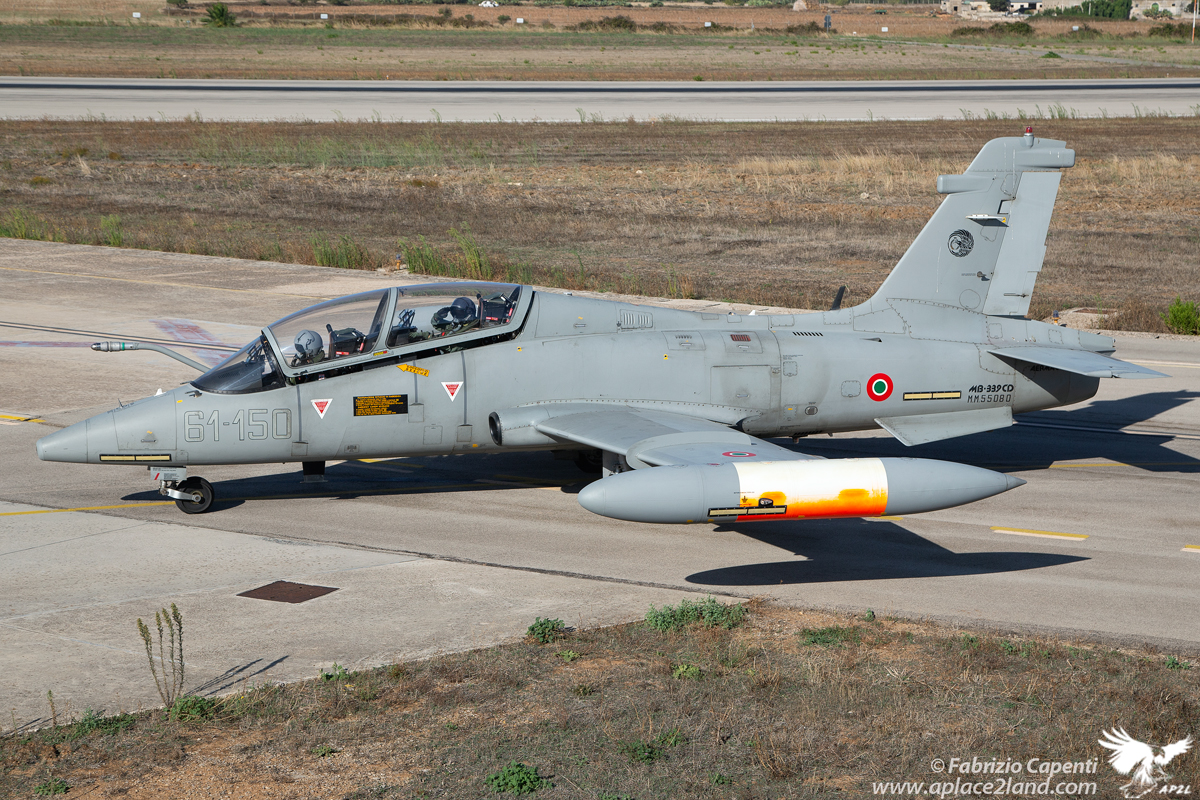
212° Gruppo
On 2015, 61° Stormo made an epochal leap in technological and qualitative terms with the introduction of the so-called Integrated Training System (ITS) used to carry out the phase 4 (LIFT) at 212° Gruppo. ITS is composed by the T-346A (AMI designation for Leonardo M-346 Master) advanced jet trainer – introduced in February 2015 – along with its associated Ground Based Training System (GBTS).
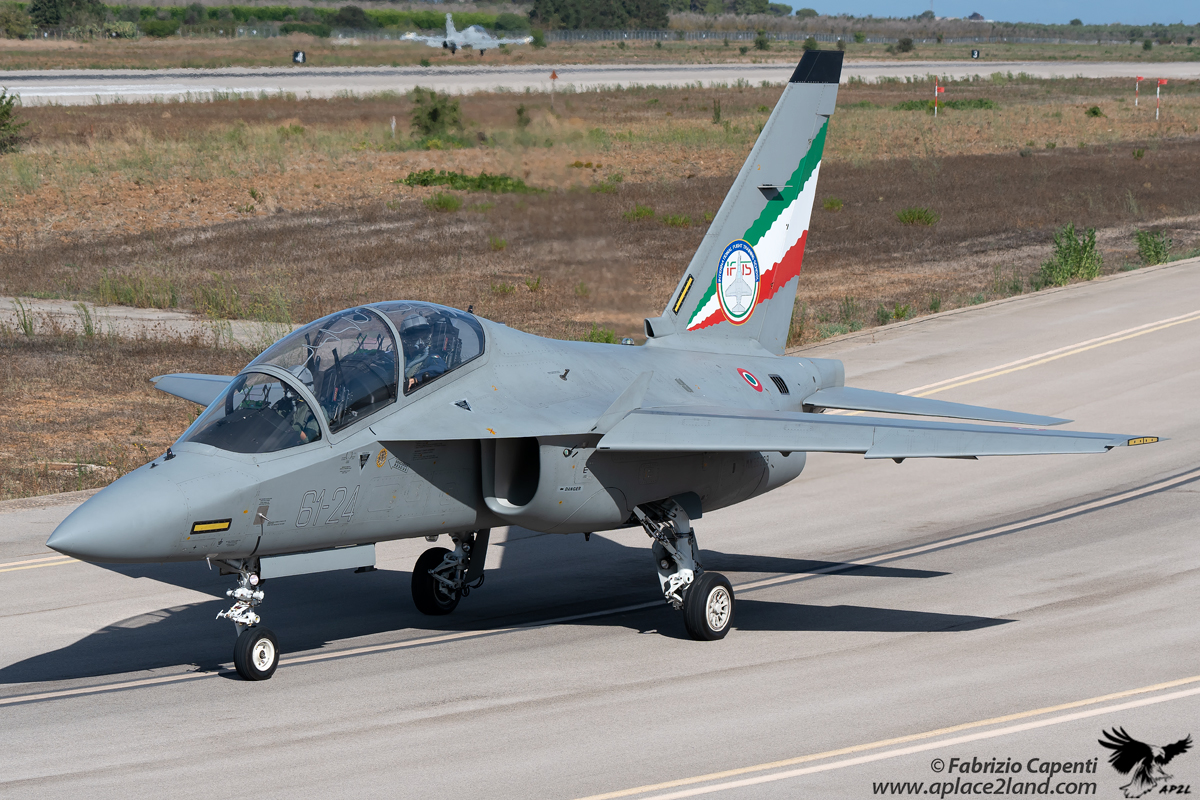
T-346A Special Tail of 61° Stormo
Talking about the latter, Major I.F. says: “During LIFT we make great use of simulators, so much so that a total of 21 sorties on the various types are normally carried out every day. Everything that is done in flight is first tested on the simulator”.
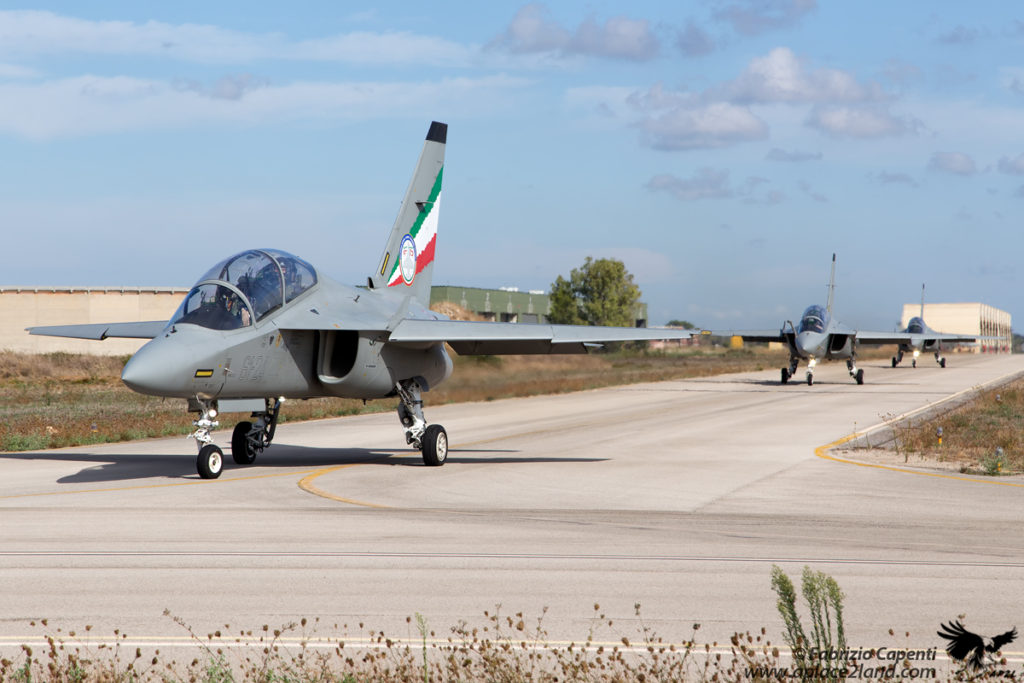
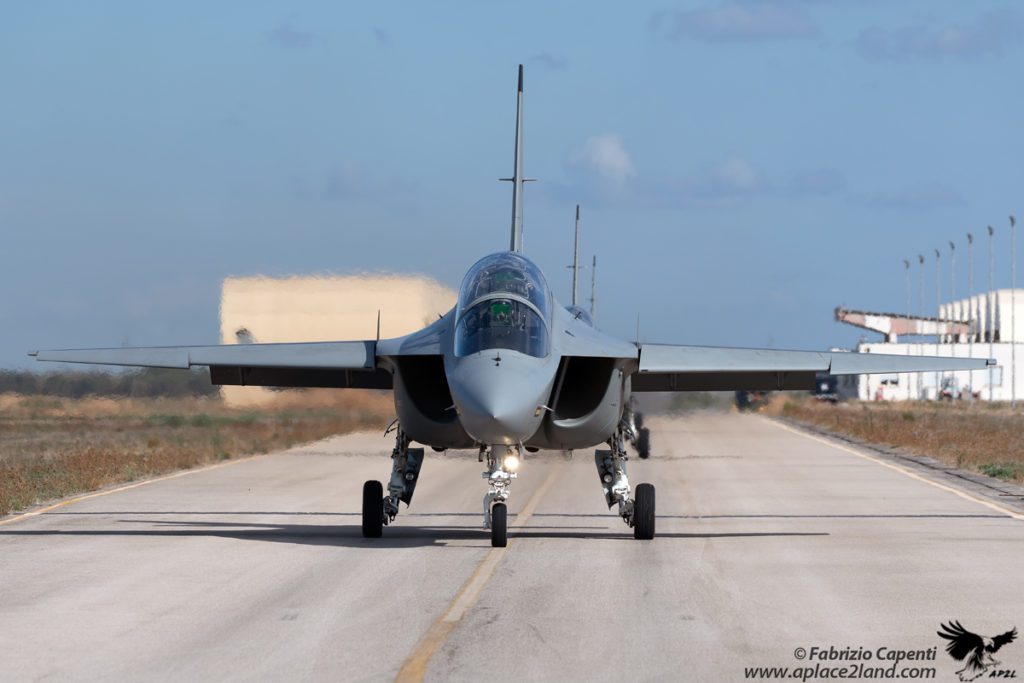
Alongside the ground school (duration of 20 days), carried out through a dedicated online platform with CBT (Computer Based Training), the trainee learns the basic aircraft systems and procedures through the basic simulator called SBT (Simulation Based Training). It consists of 9 workstations interconnected, each equipped with 6 displays and a perfect replica of ergonomics HOTAS (Hands On Throttle-And-Stick) and engine throttle that allow the familiarization with airplane’s basic settings, learning to use the throttle, make the checklist, etc.
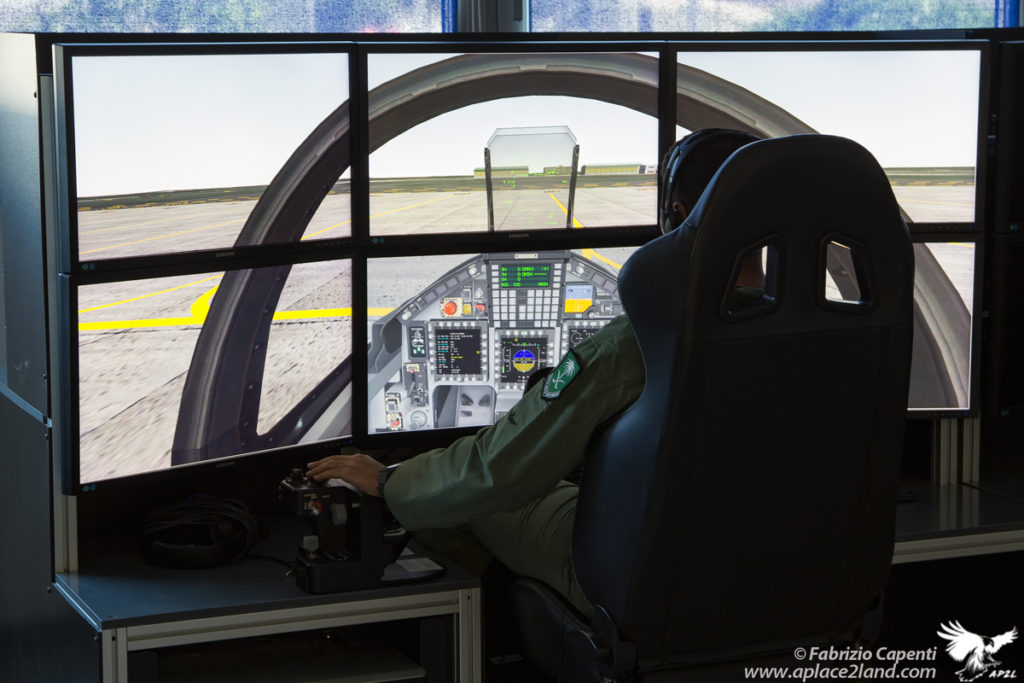
SBT (Simulation Based Training) station.
The next level is the use of PTT (Partial Task Trainer) basic simulator, equipped with a full replica of the cockpit and a 180° visual screen. It is used to put into practice the knowledge gained on CBT and SBT, taking full confidence with instrumentation, simulating basic flights, navigation flights and to handle emergencies.
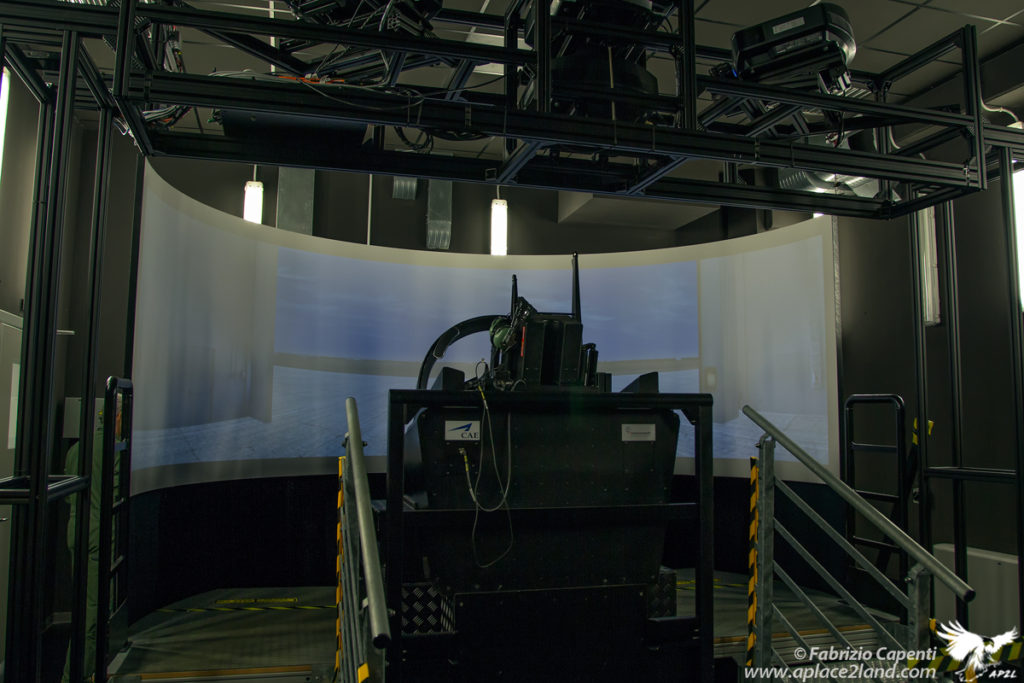
PTT (Partial Task Trainer) basic simulator
The latest and most sophisticated simulator is the FMS (Full Mission Simulator) designed by CAE (Canadian Aviation Electronics) which consists of a faithful reproduction of the cockpit of the T-346 and the dynamic G-seat, inserted inside one 360° spherical screen with 25 projectors providing images. FMS also has devices that are found in the aircraft during a real flight such as G-suit, oxygen system, HMD (helmet mounted display) and NVG (night vision goggles).
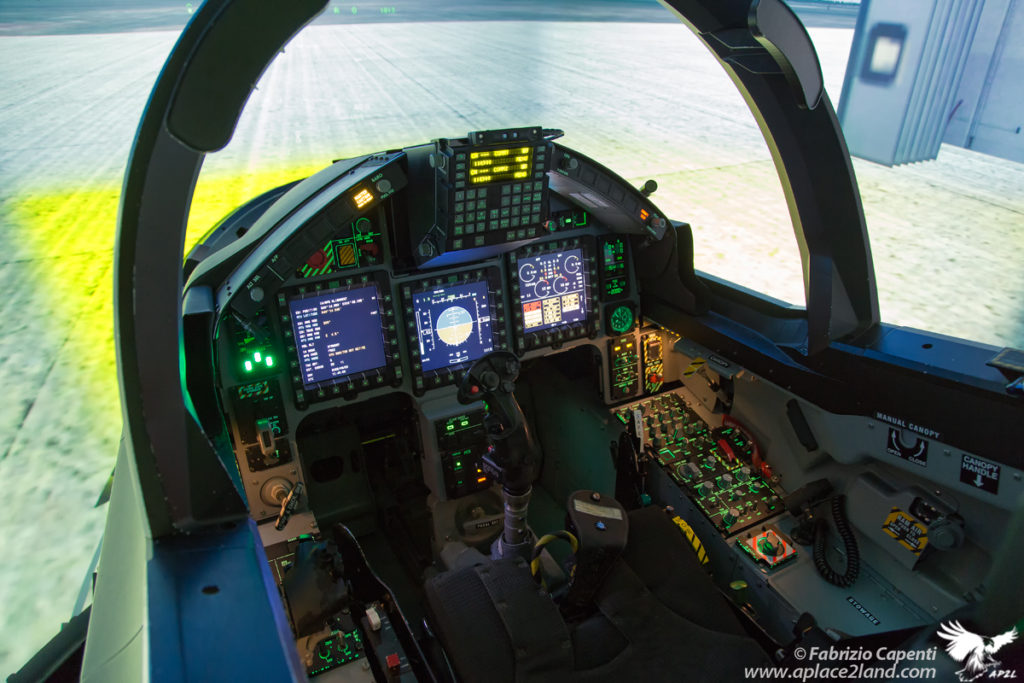
FMS (Full Mission Simulator) cockpit of M346.
PTT and FMS can be linked together and also with aircraft in flight via data link when needed.
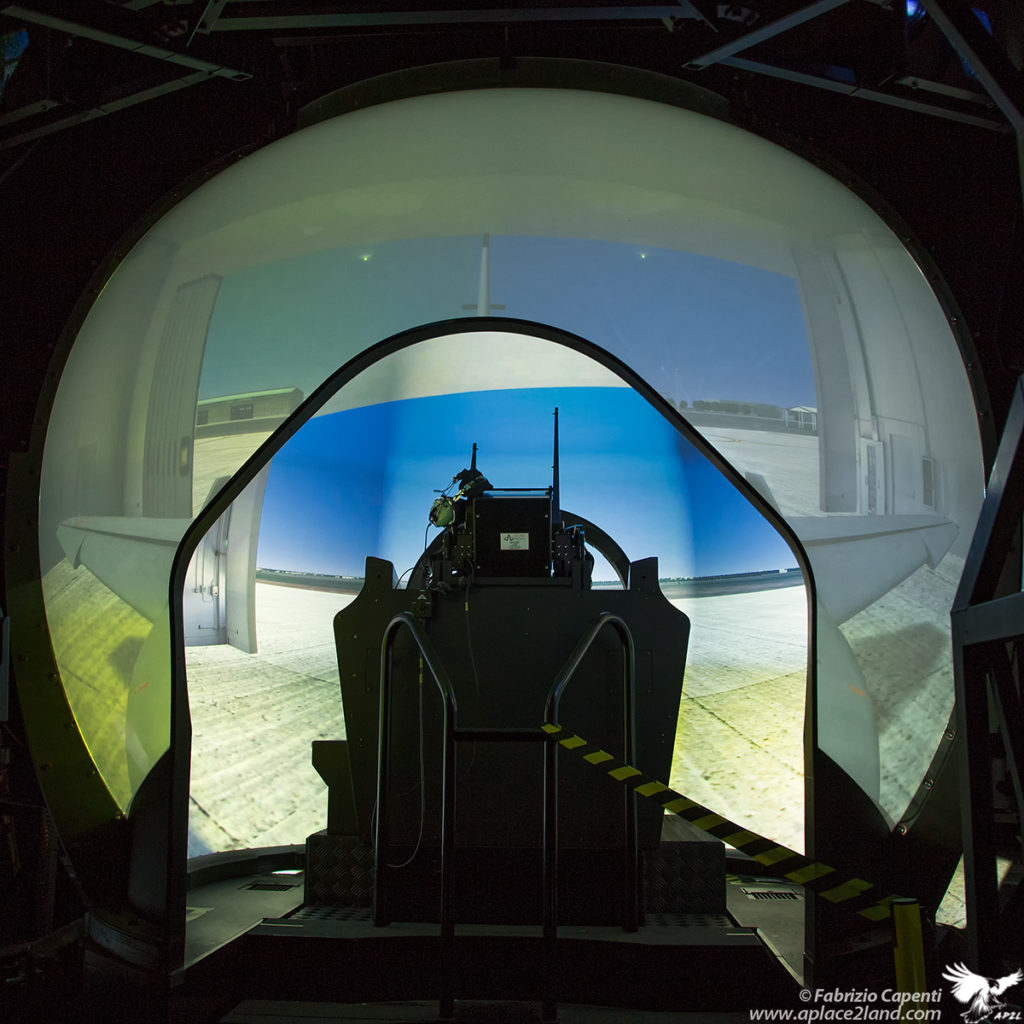
FMS (Full Mission Simulator) station. 61° Stormo
Major I.F. explain: “The aircraft features an embedded simulation capability called Embedded Tactical Training System (ETTS) which is able to simulate on-board sensors such as radar, ECM, targeting pods, weapons and can generate realistic Computer Generated Forces in a tactical scenario. This is loaded prior to take off when the ETTS work in a standalone mode. But it can also work in a network along with GBTS allows us to create what we call a Live Virtual Constructive environment: as in augmented reality the pilots who are flying on the airplane (Live) can interact with those who are at the simulator (Virtual), working together and “seeing” the same things”.
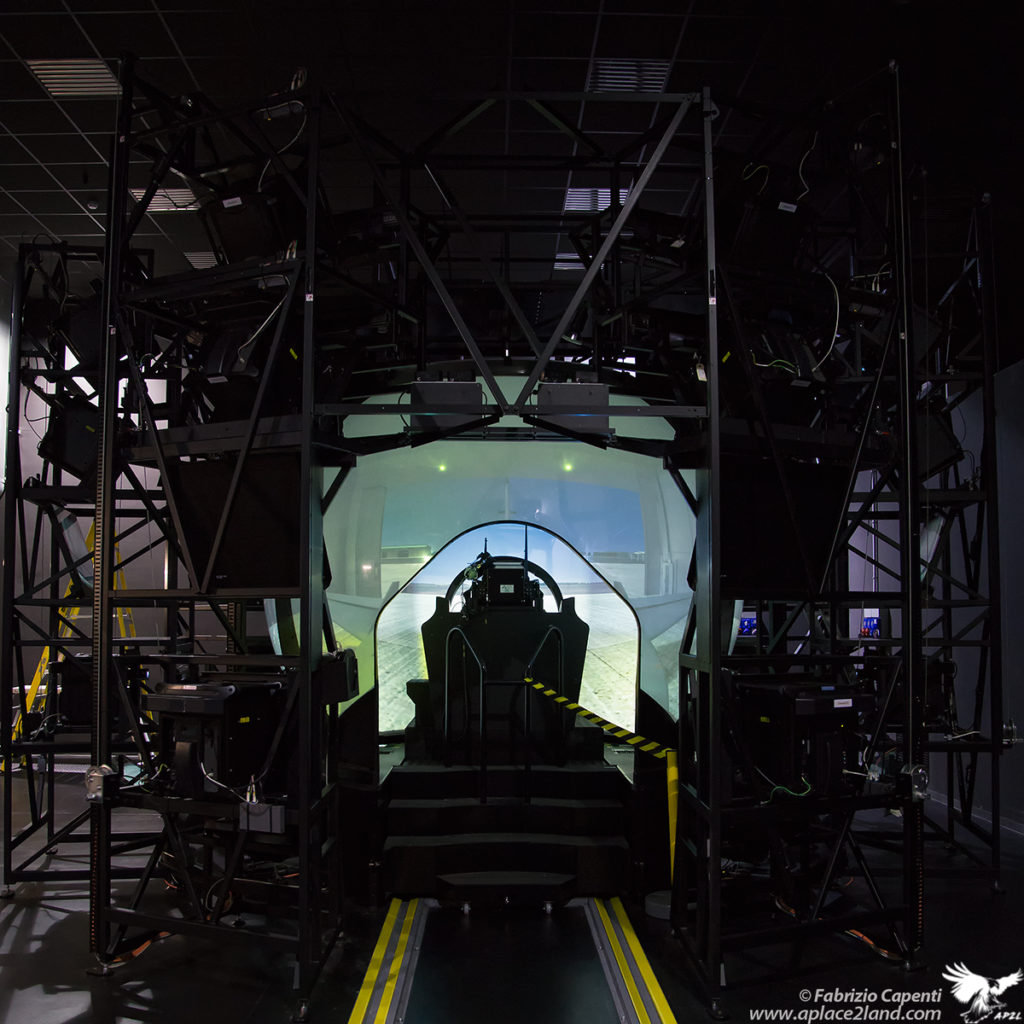
He continues: “Here on the ground through the real-time monitoring station an instructor can interact with all the pilots connected together changing the tactical scene by generating (Constructive) hostile forces such as SAM sites, ships, enemy aircraft, ground target, to enable more complex activities. At the cost of one hour flight, however, involving a larger number of planes. All the data recorded during the session can be extracted, reviewed and evaluated during post-mission briefing”.
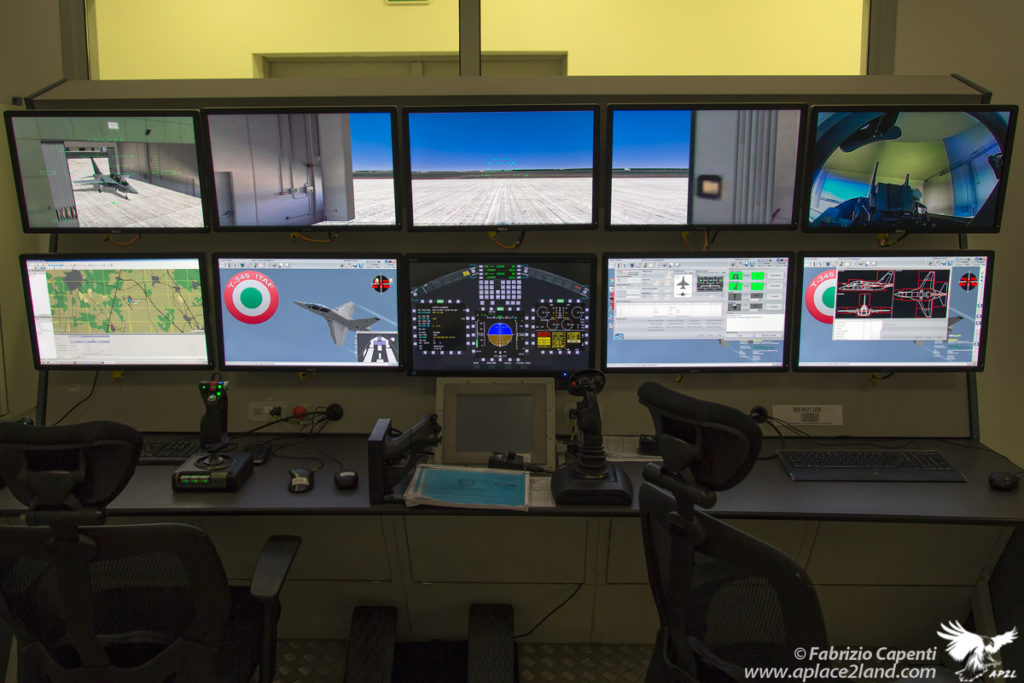
Real-time monitoring station for instructor. 61° Stormo
Regarding the LIFT course, he says: “It is done with 96 sorties (89,4 hours) at simulators and 79 flying the T-346 (89 hours). We start with the so-called “qualification” which comprise initial handling, flight patterns, instrumental flights, formation flights. It last a bit more for Qatari pilots because – unlike the other pilots – they arrive here having flown the Phase 3 on the PC-21 turboprop, and therefore need a few more missions to adapt to the jet propulsion. Then we have “advanced” training where missions focus on air-to-air, air-to-ground, aerial refueling, range and night flight with NVG. The program is eventually updated as requested by the front-line OCU because it is with them that we interface, as they are the “customers” of our product “.
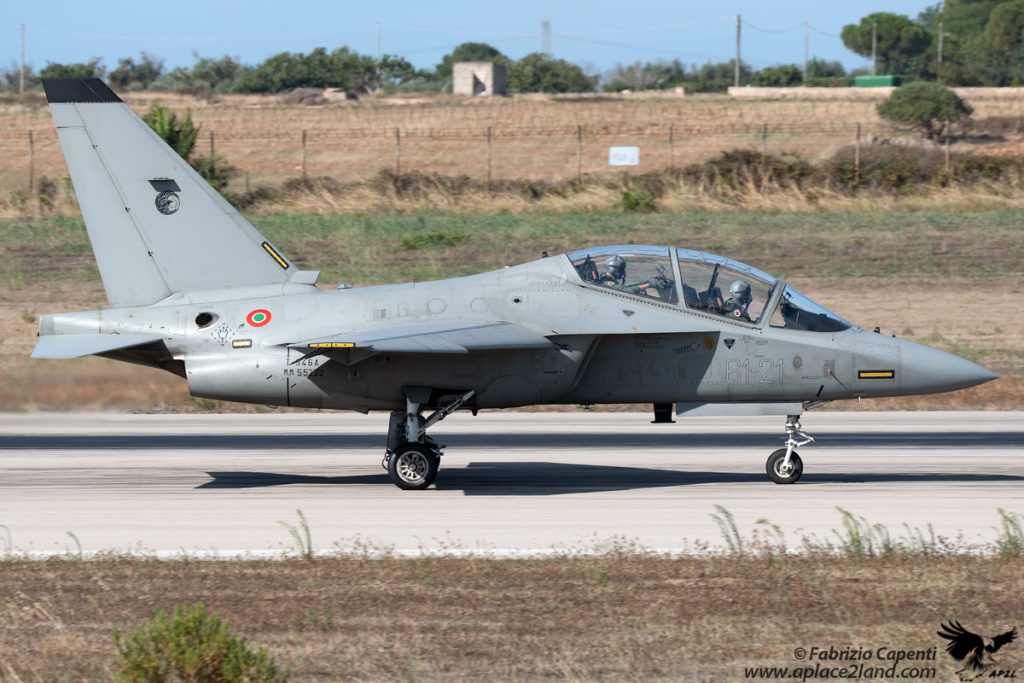
A T-346A of 61° Stormo is taking off
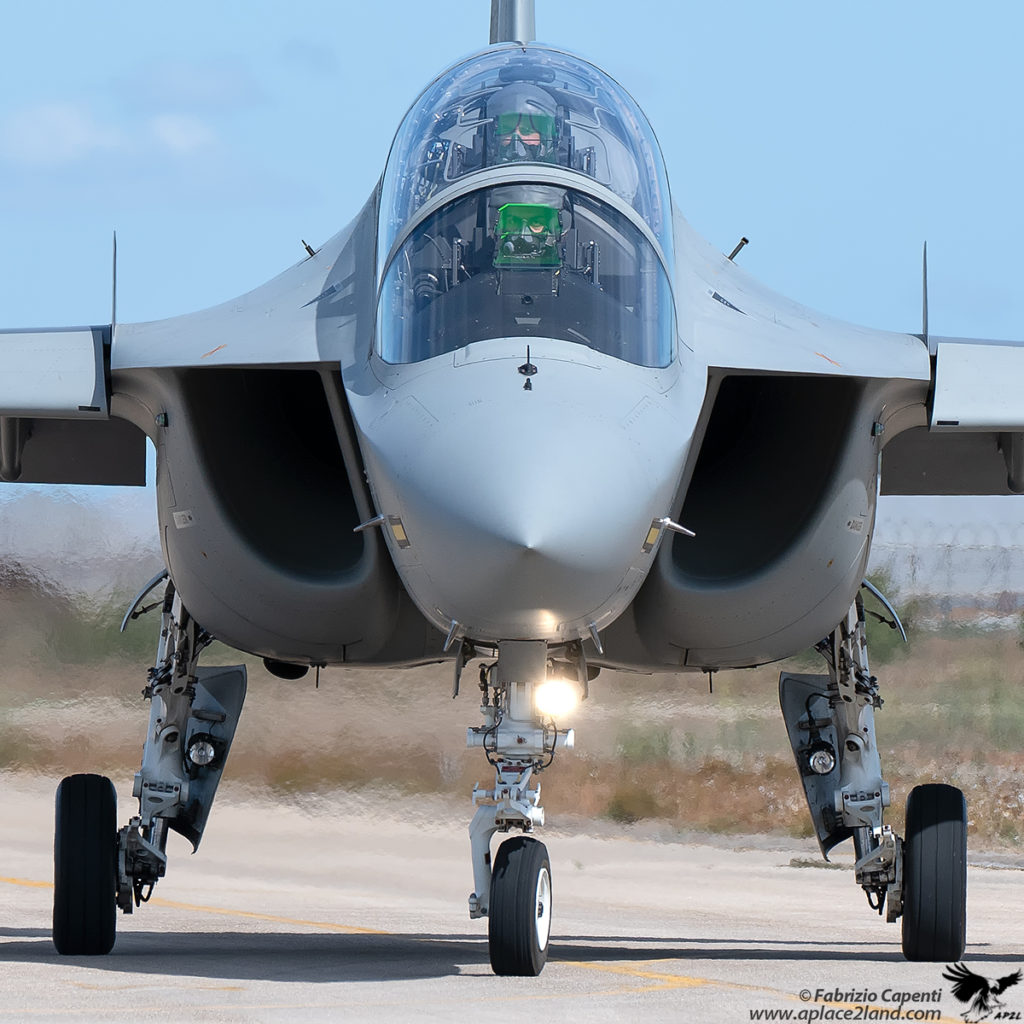
Aggressive view of a T-346 of 61° Stormo
Future of 61° Stormo and the IFTS
ITS ‘s effectiveness along with the growing demand for pre-operational fighter training has exponentially increased the interest from abroad towards the 61° Stormo. This has also favored the creation of the International Flight Training School (IFTS), a partnership between the AMI and the Leonardo company, synergy between public and private institutions.
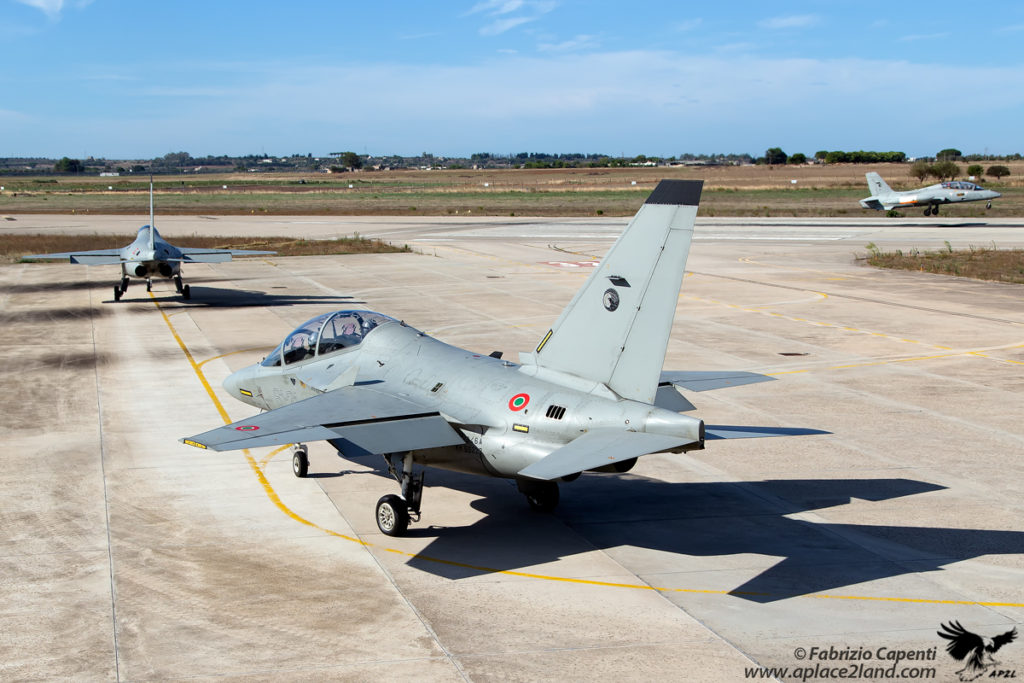
Two types of aircrafts used by 61° Stormo: T-346A and Mb-339A
The first has a leading role, providing training expertise by establishing, supervising, evaluating and guaranteeing the quality standards and training also the civilian instructors belonging to the IFTS’s and those destined to operate with simulators.
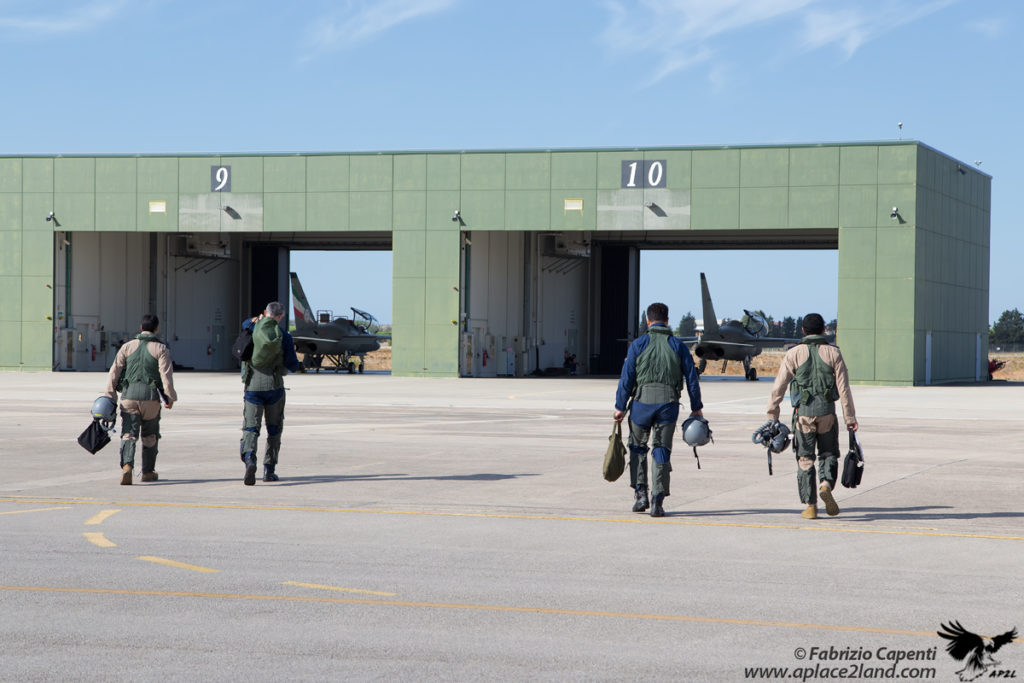
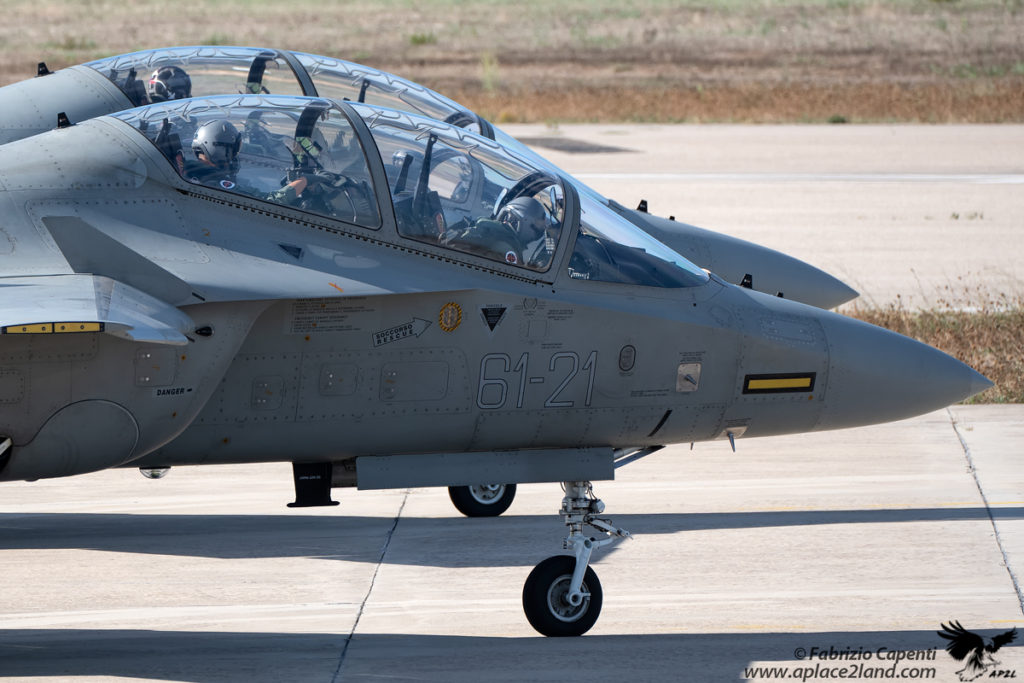
Leonardo provides, along with his own 4 M-346, civilian instructors and technical ground personnel for maintenance and logistical support of the fleet of and simulators.
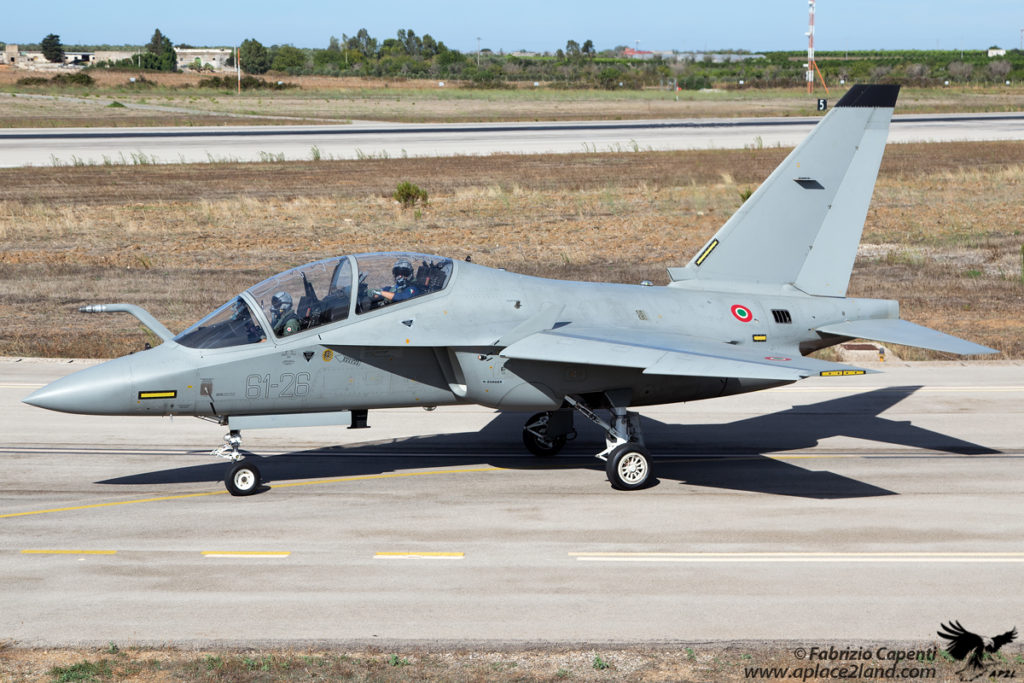
Operating with AMI’s serials, but responsibility of Leonardo are also the Qatar Emiri Air Force T-346s (6 aircraft, which differ from AMI ones due to few modification inside cockpit and different IFF).
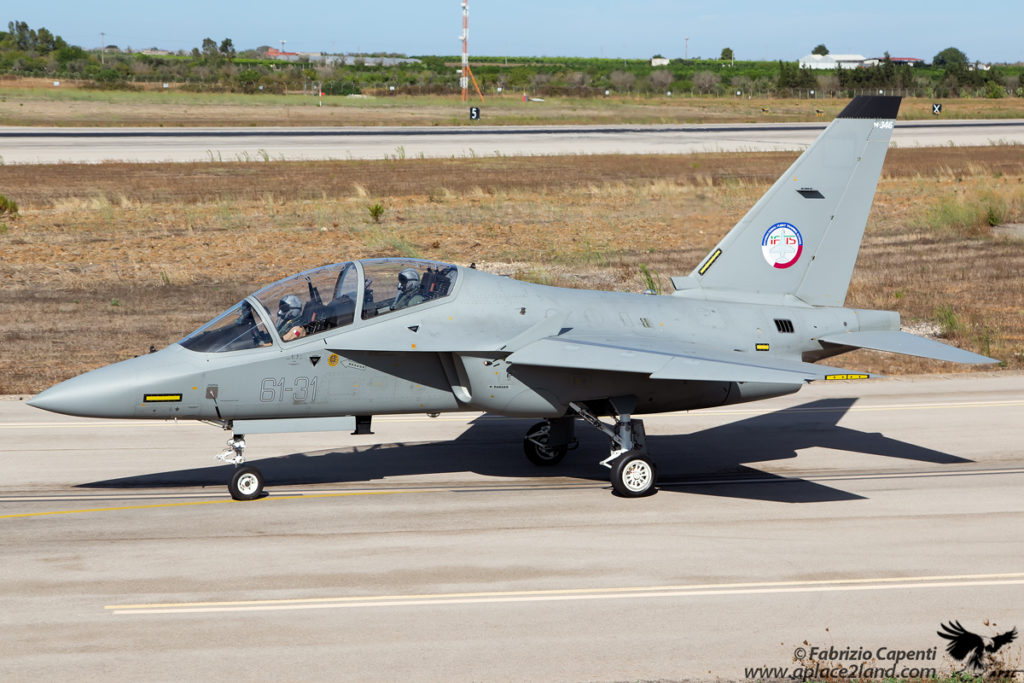
T-346B used by Qatari pilots
“ Although it will continue to depend on the 61° Stormo, the future of the 212° Gruppo and the IFTS will be far from Galatina. The high number of pilots that the IFTS brought here to Galatina meant that the spaces, both inside the airport and in the neighboring airspace, were no longer sufficient to handle this workload. The transfer to Decimomannu Air Base, Sardinia, has already begun. In 2023, when 212° Gruppo and IFTS will be permanently based, integrated and fully operational there, the flying activity will be comparable to the total flown here by the three Gruppi together. At the moment we have about 60 pilots in training but thanks to the large training spaces, the possibility of using the new dedicated buildings, adding new simulators and the presence of shooting ranges, the forecast is to be able to double this number” concludes Major I.F.
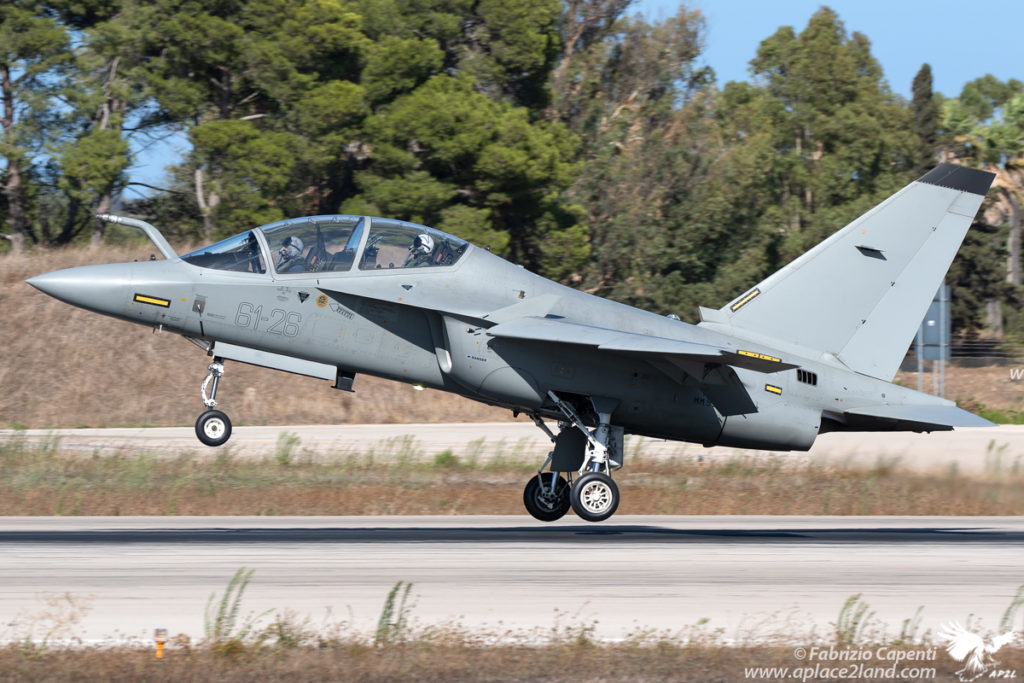
T-346A few feet above the runway. Here at 61° Stormo the refuelling probe is installed if required for refuelling training mission
A further step for the school will be related to the MB-339’s replacement within 213° Gruppo and 214° Gruppo. Even if the MB-339 is still – after 40 years, over 400,000 flight hours achieved and more than 2,500 trained pilots – being recognized as a good trainer, robust, reliable and “easy” to fly, is starting to become difficult to maintain. A withdrawal date has not been decided yet but its replacement will take place with the T-345A (Leonardo M-345).
Despite having the performance and effectiveness of a jet, the T-345 has operating costs comparable with those of a turboprop, simplified maintenance and borrowing from the T-346A the ETTS along with the ITS concept, thus allowing to maintain, after 60 years, the characteristic training philosophy “jet ab initio” at 61° Stormo.
The author would express its gratitude to Aeronautica Militare Italiana, to SMA’s Press Office, to the Commander of 61° Stormo, Col. F. Nannelli, along with the personnel of the three Gruppi Volo for the opportunity to make this report. In particular a heartfelt thanks to both Magg. A.Guerrieri and Primo Graduato A.Sticchi for their great help during the visit..
